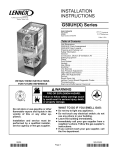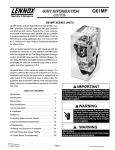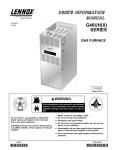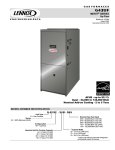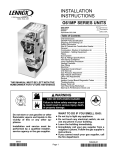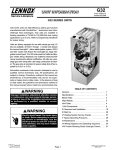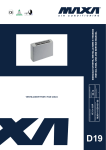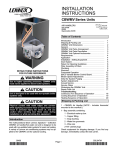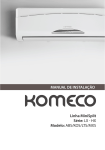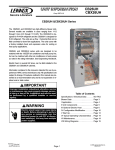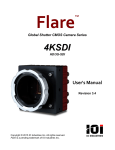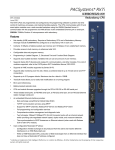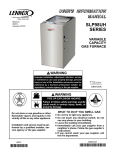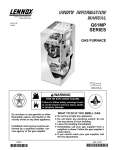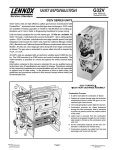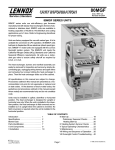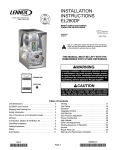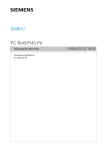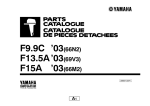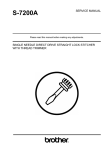Download G40UH(X) - HvacPartsShop.com
Transcript
Service Literature Corp. 0006−L3 Revised 09−2006 G40UH(X) G40UH(X) series units are mid−efficiency gas furnaces used for upflow or horizontal applications only, manufactured with Lennox Duralok Plus heat exchangers formed of aluminized steel. G40UH(X) units are available in heating capacities of 44,000 to 154,000 Btuh and cooling applications up to 5 tons. Refer to Engineering Handbook for proper sizing. Units are factory equipped for use with natural gas. Kits are available for conversion to LPG operation. G40UH(X) model units are equipped with a hot surface ignition system. The G40UH(X) unit meets the California Nitrogen Oxides (NOx) Standards and California Seasonal Efficiency requirements. All units use a redundant gas valve to assure safety shut−off as required by C.S.A. All specifications in this manual are subject to change. Procedures outlined in this manual are presented as a recommendation only and do not supersede or replace local or state codes. In the absence of local or state codes, the guidelines and procedures outlined in this manual (except where noted) are recommended only and do not constitute code. TABLE OF CONTENTS Specifications . . . . . . . . . . . . . . . . . . . . . . . . . . . . . Page 2 Blower Data . . . . . . . . . . . . . . . . . . . . . . . . . . . . . . Page 4 IMPORTANT Improper installation, adjustment, alteration, service or maintenance can cause property damage, personal injury or loss of life. Installation and service must be performed by a qualified installer, service agency or the gas supplier. High Altitude . . . . . . . . . . . . . . . . . . . . . . . . . . . . . Page 13 Parts Identification . . . . . . . . . . . . . . . . . . . . . . . . Page 14 I Unit Components . . . . . . . . . . . . . . . . . . . . . . . Page 16 II Installation . . . . . . . . . . . . . . . . . . . . . . . . . . . . . Page 24 III Start Up . . . . . . . . . . . . . . . . . . . . . . . . . . . . . . . Page 24 IV Heating System Service Checks . . . . . . . . . Page 24 WARNING Electric shock hazard. Can cause injury or death. Before attempting to perform any service or maintenance, turn the electrical power to unit OFF at disconnect switch(es). Unit may have multiple power supplies. V Typical Operating Characteristics . . . . . . . . . Page 28 VI Maintenance . . . . . . . . . . . . . . . . . . . . . . . . . . Page 28 VII Wiring and Sequence of Operation . . . . . . Page 30 VIII SureLight Troubleshooting Guide . . . . . . . Page 41 Page 1 WARNING Sharp edges. Be careful when servicing unit to avoid sharp edges which may result in personal injury. © 2000 Lennox Industries Inc. SPECIFICATIONS ModelNo. G40UH −24A−045 Low NOx Model No. −24A−045X Gas Heating Performance 1 G40UH −24A−070 −−− G40UH −36A−070 −36A−070X G40UH −48B−070 −−− G40UH −36B−090 −−− G40UH −48B−090 −48B−090X Input− Btuh 44,000 44,000 66,000 66,000 66,000 88,000 88,000 Output− Btuh 36,000 35,900 54,100 54,100 54,000 72,100 72,100 2 AFUE 80.0% 80.0% 80.0% 80.0% 80.0% 80.0% 80.0% Highstatic(CSA)− in.w.g. .50 .50 .50 .50 .50 .50 .50 Temperature rise range − _F 35 − 65 25 − 55 40 − 70 40 − 70 25 − 55 40 − 70 40 − 70 4 4 4 4 4 4 4 1/2 1/2 1/2 1/2 1/2 1/2 1/2 10 x 7 10 x 8 10 x 7 10 x 8 10 x 10 10 x 8 10 x 10 1/5 1/3 1/5 1/3 1/2 1/3 1/2 1.5 − 2 2−3 1.5 − 2 2−3 2−4 2−3 3−4 121 126 127 132 139 146 153 Connections Flue − in. (round) GaspipesizeIPS− in. Indoor Blower G40UH −36A−045 −−− Wheelnom.dia. xwidth −in. Motoroutput − hp Tons ofadd-oncooling ShippingData lbs. − 1 package Electricalcharacteristics Gas Heating g P f Performance 120 volts − 60 hertz − 1 phase (less than 12 amps) 1 G40UH −36C−110 −−− G40UH −48C−110 −−− G40UH −60C−110 −60C−110X G40UH −48C−135 −−− G40UH −60D−135 −−− G40UH −60D−155 −−− Input− Btuh 110,000 110,000 110,000 132,000 132,000 154,000 Output− Btuh 90,200 88,500 89,400 106,900 106,900 124,700 2 AFUE 80.0% 80.0% 80.0% 80.0% 80.0% 80.0% Highstatic(CSA)− in.w.g. .50 .50 .50 .50 .50 .50 Temperature rise range − _F 50 − 80 40 − 70 30 − 60 50 − 80 45 − 75 50 − 80 4 4 4 34 34 34 1/2 1/2 1/2 1/2 1/2 1/2 10 x 8 10 x 10 11−1/2 x 10 10 x 10 11−1/2 x 10 11−1/2 x 10 1/3 1/2 1 1/2 1 1 Tons ofadd-oncooling 2−3 3−4 4−5 2.5 − 4 4−5 4−5 lbs. − 1 package 166 169 175 178 195 204 ModelNo. Low NOx Model No. Connections Flue − in. (round) GaspipesizeIPS− in. Indoor Blower Wheelnom.dia. xwidth −in. Motoroutput − hp ShippingData Electricalcharacteristics 120 volts − 60 hertz − 1 phase (less than 12 amps) NOTE − Filters and provisions for mounting are not furnished and must be field provided. 1 Canada Only 2 Annual Fuel Utilization Efficiency based on DOE test procedures and according to FTC labeling regulations. Isolated combustion system rating for non-weatherized furnaces. 3 Flue connection on the unit is 4 in. diameter. Most applications will require 5 in. venting and field supplied 4 x 5 in. adaptor. See Venting Tables in the Installation Instructions for detailed information. Page 2 SPECIFICATIONS ModelNo. G40UH−60C−110 −1, −2, −3 units G40UH−60D−135 −1, −2, −3 units G40UH−60D−155 −1, −2, −3 units Input− Btuh (kW) 110,000 (32.2) 132,000 (38.7) 154,000 (45.1) Output− Btuh (kW) 90,200 (26.4) 106,900 (31.3) 124,700 (36.5) lAFUE 80.0% 80.0% 80.0% California Seasonal Efficiency 75.7% 75.0% 75.6% .50 (124) .50 (124) .50 (124) Gas Heating Performance Highstatic(AGA/CGA)− in.w.g. (Pa) Flue connection − in. (mm) round GaspipesizeIPS− in. (mm) Temperature rise range − _F (_C) Indoor Blower 4 (102) 4 (102) 4 (102) 1/2 (12.7) 1/2 (12.7) 1/2 (12.7) 35 − 65 (19 − 36) 45 − 75 (25 − 42) 50 − 80 (28 − 44) Wheelnominaldiameter xwidth −in. (mm) 11−1/2 x 10 (292 x 254) 11−1/2 x 10 (292 x 254) 11−1/2 x 10 (292 x 254) Motoroutput − hp (W) Tons(kW) ofadd-oncooling Shippingweight − 1 package Matching Coils Up−flow cased Horizontal Electricalcharacteristics 3/4 (560) 3/4 (560) 3/4 (560) 5 (17.6) 5 (17.6) 5 (17.6) 172 lbs. (78 kg) 192 lbs. (87 kg) 201 lbs. (91 kg) C33−36C−2F, C33−48C−2F, C33−50/60C−2F, C33−60D−2F, C33−62D−2F CH33−36C−2F, CH33−48C−2F, CH33−50/60C−2F CH33−60D−2F, CH33−62D−2F 120 volts − 60 hertz − 1 phase (less than 12 amps) OPTIONAL ACCESSORIES − MUST BE ORDERED EXTRA A" Width Models B" Width Models C" Width Models D" Width Models FILTER KITS 1 Air Filter and Rack Kit Horizontal (end) Catalog No. 87L95 87L96 87L97 87L98 Size of filter − in. 14 x 25 x 1 18 x 25 x 1 20 x 25 x 1 25x25 x 1 Single 44J22 44J22 44J22 44J22 Ten Pack 66K63 66K63 66K63 66K63 Side Return EZ Filter Base Up−Flow Only Size of filter − in. 16 x 25 x 1 16 x 25 x 1 16 x 25 x 1 16 x 25 x 1 Catalog No. − Ship. Wt. − lbs. 73P55 − 7 73P56 − 7 73P57 − 8 73P58 − 10 Size of field provided filter − in. 14 x 25 x 1 16 x 25 x 1 20 x 25 x 1 24 x 24 x 1 56J18 56J18 56J18 56J18 −−− 98M60 98M58 98M59 15L38 15L38 15L38 15L38 18M79 18M79 18M79 18M79 CABINET ACCESSORIES Horizontal Support Frame Kit − Horizontal Only Return Air Base − Up−Flow Only CONTROLS Twinning Kit VENTING Vent Adaptor − 6 in. connection size up−flow applications only LPG/Propane Kits 1 See Page 13 Cleanable polyurethane frame type filter. Page 3 BLOWER DATA G40UH−24A−045 PERFORMANCE Air Volume / Watts at Various Blower Speeds External Static Pressure High Medium Low in. w.g. Pa cfm L/s Watts cfm L/s Watts cfm L/s Watts 0.00 0 1090 515 460 905 425 390 725 340 300 0.05 12 1080 510 450 900 425 390 720 340 300 0.10 25 1065 505 445 895 420 385 710 335 295 0.15 37 1050 495 435 895 420 380 700 330 290 0.20 50 1030 485 425 890 420 375 690 325 290 0.25 62 1015 480 415 875 415 370 680 320 285 0.30 75 995 470 410 860 405 365 665 315 280 0.40 100 960 455 395 840 395 350 650 305 270 0.50 125 910 430 380 795 375 335 610 290 260 0.60 150 840 395 355 750 355 315 540 255 245 0.70 175 770 365 340 665 315 295 490 230 235 0.80 200 660 310 315 555 260 275 420 200 225 0.90 225 560 265 295 480 225 260 355 170 210 NOTE − All air data is measured external to unit with 1 in. (25 mm) cleanable filter (not furnished − field provided) in place. Also see Filter Air Resistance table. G40UH−24A−070 PERFORMANCE Air Volume / Watts at Various Blower Speeds External Static Pressure High Medium Low in. w.g. Pa cfm L/s Watts cfm L/s Watts cfm L/s Watts 0.00 0 1075 505 445 905 425 375 730 345 290 0.05 12 1070 505 445 900 425 375 725 340 290 0.10 25 1065 505 440 895 420 370 720 340 285 0.15 37 1060 500 435 890 420 365 715 335 285 0.20 50 1055 500 430 885 420 360 710 335 280 0.25 62 1045 495 425 880 415 360 700 330 280 0.30 75 1030 485 415 875 415 355 690 325 270 0.40 100 1010 475 400 860 405 350 675 320 270 0.50 125 975 460 390 840 395 340 660 310 265 0.60 150 940 445 375 805 380 325 640 300 255 0.70 175 890 420 360 755 355 305 605 285 240 0.80 200 830 390 340 700 330 285 565 265 225 0.90 225 765 360 305 640 300 265 515 245 205 NOTE − All air data is measured external to unit with 1 in. (25 mm) cleanable filter (not furnished − field provided) in place. Also see Filter Air Resistance table. Page 4 BLOWER DATA G40UH−36A−045 PERFORMANCE External Static Pressure Air Volume / Watts at Various Blower Speeds Medium−High Medium−Low cfm Watts cfm Watts 1300 545 1100 460 1290 530 1100 450 1280 520 1100 445 1275 505 1095 435 1260 495 1090 425 1250 485 1090 420 1235 470 1075 410 1195 450 1060 390 1160 430 1020 375 1105 410 975 350 1045 380 910 325 915 345 810 300 815 320 725 270 High in. w.g. 0.00 0.05 0.10 0.15 0.20 0.25 0.30 0.40 0.50 0.60 0.70 0.80 0.90 cfm 1480 1465 1445 1440 1415 1400 1375 1320 1265 1210 1135 1025 885 Watts 615 605 585 585 570 560 545 520 495 475 450 415 380 Low cfm 930 930 930 935 935 930 930 915 890 840 775 720 640 Watts 385 380 370 365 360 355 350 330 320 295 280 265 240 NOTE − All air data is measured external to unit with 1 in. cleanable filter (not furnished − field provided) in place. Also see Filter Air Resistance table. G40UH−36A−070 PERFORMANCE Air Volume / Watts at Various Blower Speeds External Static Pressure High Medium−High Medium−Low Low in. w.g. 0.00 Pa 0 cfm 1500 L/s 710 Watts 705 cfm 1290 L/s 610 Watts 565 cfm 985 L/s 465 Watts 455 cfm 830 L/s 390 Watts 375 0.05 12 1475 695 695 1275 600 555 980 465 445 820 385 365 0.10 25 1450 685 680 1255 590 545 970 460 440 810 380 360 0.15 37 1425 675 670 1240 585 535 965 455 430 805 380 355 0.20 50 1400 660 655 1225 580 525 955 450 425 795 375 350 0.25 62 1370 645 645 1205 570 510 945 445 415 790 375 345 0.30 75 1340 630 630 1180 555 500 930 440 405 780 370 335 0.40 100 1285 605 610 1140 540 475 900 425 390 745 350 325 0.50 125 1215 575 580 1080 510 450 865 410 375 705 335 310 0.60 150 1150 545 560 1015 480 430 810 380 355 655 310 290 0.70 175 1060 500 535 940 445 405 730 345 330 585 275 270 0.80 200 955 450 515 800 375 370 655 310 305 480 225 260 0.90 225 785 370 475 605 285 325 585 275 270 410 195 255 NOTE − All air data is measured external to unit with 1 in. (25 mm) cleanable filter (not furnished − field provided) in place. Also see Filter Air Resistance table. G40UH−36B−090 PERFORMANCE Air Volume / Watts at Various Blower Speeds External Static Pressure High Medium−High Medium−Low Low in. w.g. Pa cfm L/s Watts cfm L/s Watts cfm L/s Watts cfm L/s Watts 0.00 0 1500 710 720 1255 590 595 1040 490 460 900 425 370 0.05 12 1485 700 705 1250 590 580 1040 490 450 895 420 365 0.10 25 1465 690 685 1240 585 570 1035 490 445 890 420 360 0.15 37 1450 685 675 1235 585 555 1035 490 440 885 420 355 0.20 50 1435 675 660 1225 580 545 1030 485 435 880 415 350 0.25 62 1420 670 645 1215 575 530 1025 485 425 875 415 345 0.30 75 1400 660 630 1200 565 520 1020 480 415 870 410 340 0.40 100 1345 635 595 1170 550 495 1000 470 400 855 405 330 0.50 125 1300 615 575 1135 535 475 965 455 380 830 390 300 0.60 150 1235 585 545 1080 510 445 930 440 360 780 370 290 0.70 175 1165 550 510 1020 480 415 870 410 340 740 350 280 0.80 200 1080 510 480 940 445 385 800 380 315 670 315 260 0.90 225 985 465 445 840 395 355 710 335 290 600 285 245 NOTE − All air data is measured external to unit with 1 in. (25 mm) cleanable filter (not furnished − field provided) in place. Also see Filter Air Resistance table. Page 5 BLOWER DATA G40UH−36C−110 PERFORMANCE Air Volume / Watts at Various Blower Speeds External Static Pressure High Medium−High Medium−Low Low in. w.g. Pa cfm L/s Watts cfm L/s Watts cfm L/s Watts cfm L/s Watts 0.00 0 1555 735 715 1335 630 575 1085 510 460 925 435 365 0.05 12 1540 725 705 1330 630 555 1080 510 450 920 435 360 0.10 25 1525 720 690 1320 625 545 1075 505 440 915 430 355 0.15 37 1510 715 680 1310 620 535 1070 505 430 910 430 350 0.20 50 1490 705 670 1295 610 525 1065 505 420 900 425 340 0.25 62 1465 690 655 1280 605 510 1060 500 415 890 420 335 0.30 75 1440 680 645 1260 595 495 1050 495 405 880 415 330 0.40 100 1385 655 615 1230 580 485 1030 485 390 865 410 320 0.50 125 1320 625 590 1190 560 460 995 470 375 835 395 300 0.60 150 1260 595 570 1135 535 430 960 455 355 815 385 295 0.70 175 1190 560 545 1075 505 410 915 430 345 775 365 285 0.80 200 1090 515 515 970 460 385 860 405 325 760 360 280 0.90 225 975 460 485 880 415 360 790 375 305 705 335 275 NOTE − All air data is measured external to unit with 1 in. (25 mm) cleanable filter (not furnished − field provided) in place. Also see Filter Air Resistance table. G40UH−48B−070 PERFORMANCE Air Volume / Watts at Different Blower Speeds External Static Pressure High Medium−High Medium−Low Low in. w.g. .00 Pa 0 cfm 2080 L/s 980 Watts 846 cfm 1810 L/s 855 Watts 764 cfm 1535 L/s 725 Watts 634 cfm 1295 L/s 610 Watts 519 .10 25 2030 955 810 1790 845 714 1520 715 600 1285 605 492 .20 50 1955 920 767 1760 830 675 1515 715 566 1275 600 477 .30 75 1885 890 732 1710 805 640 1505 710 555 1265 595 459 .40 100 1820 860 699 1670 790 611 1470 695 525 1255 590 443 .50 125 1740 820 664 1600 755 575 1420 670 496 1215 575 414 .60 150 1635 770 624 1530 720 544 1350 635 464 1175 555 400 .70 175 1545 730 597 1420 670 501 1270 600 432 1080 510 368 .80 200 1400 660 554 1295 610 462 1135 535 392 990 465 343 .90 225 1250 590 512 1125 530 419 1050 495 372 875 410 310 NOTES − All air data is measured external to unit with 1 in. (25 mm) cleanable filter (not furnished − field provided) in place. Also see Filter Air Resistance table. Air volume based on bottom air return air. Actual air volume may vary on side return air applications. G40UH−48B−090 PERFORMANCE Air Volume / Watts at Various Blower Speeds External Static Pressure High Medium−High Medium−Low Low in. w.g. Pa cfm L/s Watts cfm L/s Watts cfm L/s Watts cfm L/s Watts 0.00 0 1970 930 790 1810 855 735 1585 750 670 1340 630 565 0.05 12 1940 915 780 1785 840 715 1580 745 650 1335 630 555 0.10 25 1915 905 765 1760 830 695 1570 740 630 1325 625 540 0.15 37 1880 885 745 1730 815 660 1560 735 615 1325 625 530 0.20 50 1840 870 730 1700 800 620 1545 730 600 1320 625 520 0.25 62 1805 850 715 1670 790 625 1520 715 585 1310 620 510 0.30 75 1765 835 695 1640 775 625 1490 705 565 1295 610 500 0.40 100 1695 800 670 1570 740 595 1440 680 540 1260 595 480 0.50 125 1600 755 635 1490 705 560 1360 640 505 1195 565 450 0.60 150 1505 710 600 1400 660 530 1285 605 480 1140 540 425 0.70 175 1395 660 565 1265 595 485 1170 550 440 990 465 380 0.80 200 1250 590 520 1100 520 445 975 460 390 905 425 355 0.90 225 1005 475 460 870 410 385 900 425 365 810 380 325 NOTE − All air data is measured external to unit with 1 in. (25 mm) cleanable filter (not furnished − field provided) in place. Also see Filter Air Resistance table. Page 6 BLOWER DATA G40UH−48C−110 PERFORMANCE Air Volume / Watts at Various Blower Speeds External Static Pressure High Medium−High Medium−Low Low in. w.g. Pa cfm L/s Watts cfm L/s Watts cfm L/s Watts cfm L/s Watts 0.00 0 2015 950 895 1620 765 780 1340 630 640 1150 545 525 0.05 12 1990 940 870 1615 760 760 1340 630 640 1150 545 525 0.10 25 1965 925 850 1610 760 745 1340 630 640 1150 545 525 0.15 37 1930 910 825 1605 755 725 1335 630 630 1150 545 525 0.20 50 1895 895 805 1600 755 710 1335 630 615 1150 545 525 0.25 62 1860 880 785 1590 750 695 1330 630 605 1150 545 520 0.30 75 1820 860 765 1580 745 675 1330 630 590 1145 540 515 0.40 100 1740 820 725 1530 720 635 1320 625 560 1140 540 490 0.50 125 1665 785 695 1475 695 600 1285 605 525 1120 530 470 0.60 150 1575 745 650 1405 665 555 1230 580 490 1075 505 445 0.70 175 1475 695 610 1310 620 515 1165 550 470 1015 480 415 0.80 200 1350 635 560 1210 570 485 1080 510 430 930 440 380 0.90 225 1210 570 520 1070 505 430 870 410 365 740 350 325 NOTE − All air data is measured external to unit with 1 in. (25 mm) cleanable filter (not furnished − field provided) in place. Also see Filter Air Resistance table. G40UH−48C−135 PERFORMANCE Air Volume / Watts at Various Blower Speeds External Static Pressure High Medium−High Medium−Low Low in. w.g. Pa cfm L/s Watts cfm L/s Watts cfm L/s Watts cfm L/s Watts 0.00 0 2075 980 820 1800 850 710 1425 675 570 1115 525 435 0.05 12 2035 960 805 1785 840 695 1425 670 560 1120 530 435 0.10 25 1990 940 790 1765 835 675 1420 670 545 1125 530 430 0.15 37 1950 920 765 1740 820 660 1410 665 535 1125 530 425 0.20 50 1905 900 745 1715 810 645 1405 665 525 1120 530 420 0.25 62 1865 880 730 1680 795 625 1390 655 515 1115 525 410 0.30 75 1825 860 715 1650 780 610 1375 650 505 1105 520 405 0.40 100 1740 820 680 1585 745 580 1355 640 485 1090 515 390 0.50 125 1640 775 645 1495 705 545 1300 615 455 1050 495 370 0.60 150 1540 730 615 1420 670 515 1225 580 430 1000 470 355 0.70 175 1420 670 575 1310 615 475 1140 535 400 935 440 330 0.80 200 1260 595 520 1155 545 425 1025 485 365 865 410 315 0.90 225 1125 530 495 1010 475 385 880 415 330 750 355 285 NOTE − All air data is measured external to unit with 1 in. (25 mm) cleanable filter (not furnished − field provided) in place. Also see Filter Air Resistance table. Page 7 BLOWER DATA G40UH−60C−110−1, −2, −3 with 3/4 hp motor PERFORMANCE − Bottom Return Air, Side Return Air with Optional RAB Return Air Base, Return Air from Both Sides or Return Air from Bottom and One Side. Air Volume / Watts at Various Blower Speeds External Static Pressure in. w.g. Pa High Medium−High Medium−Low Low cfm L/s Watts cfm L/s Watts cfm L/s Watts cfm L/s Watts 0.00 0 2450 1155 1220 2300 1085 1060 2056 970 905 1725 815 735 0.05 12 2410 1135 1205 2265 1070 1045 2040 965 895 1715 810 725 0.10 25 2370 1120 1195 2230 1050 1030 2020 955 890 1710 810 720 0.15 37 2325 1095 1175 2200 1040 1015 1995 940 875 1700 800 715 0.20 50 2280 1075 1165 2170 1025 1005 1975 935 870 1695 800 710 0.25 62 2245 1060 1150 2130 1005 990 1950 920 855 1680 795 705 0.30 75 2205 1040 1135 2095 990 975 1925 910 845 1665 785 700 0.40 100 2115 995 1105 2010 950 940 1860 875 820 1625 770 685 0.50 125 2025 955 1060 1945 920 920 1810 855 805 1605 755 675 0.60 150 1910 900 1015 1850 875 885 1715 810 780 1540 730 670 0.70 175 1835 865 1005 1775 840 865 1655 780 765 1495 705 655 0.80 200 1745 825 975 1655 780 835 1540 725 730 1400 660 635 0.90 225 1610 760 945 1540 725 805 1475 695 715 1310 620 615 NOTE − All air data is measured external to unit with 1 in. (25 mm) cleanable filter (not furnished − field provided) in place. Also see Filter Air Resistance table. G40UH−60C−110−1, −2, −3 with 3/4 hp motor PERFORMANCE − Single Side Return Air − Air volumes in bold require field fabricated transition to accommodate 20 x 25 x 1 in. (508 x 635 x25 mm) cleanable air filter in order to maintain proper air velocity. Air Volume / Watts at Various Blower Speeds External Static Pressure High Medium−High Medium−Low Low in. w.g. Pa cfm L/s Watts cfm L/s Watts cfm L/s Watts cfm L/s Watts 0.00 0 2395 1130 1230 2260 1065 1085 2015 950 920 1730 815 750 0.05 12 2365 1115 1220 2230 1050 1070 1985 935 905 1720 810 745 0.10 25 2330 1100 1205 2200 1040 1060 1960 925 890 1705 805 750 0.15 37 2285 1080 1190 2170 1025 1045 1030 485 880 1695 800 740 0.20 50 2245 1060 1170 2135 1010 1030 1905 900 870 1675 790 735 0.25 62 2200 1040 1160 2100 990 1020 1890 890 860 1665 785 730 0.30 75 2170 1025 1145 2070 980 1005 1870 880 850 1655 780 720 0.40 100 2085 985 1110 1990 940 975 1825 860 835 1610 760 705 0.50 125 1980 935 1075 1910 900 945 1755 830 810 1555 735 690 0.60 150 1890 890 1045 1835 865 915 1670 790 780 1515 715 680 0.70 175 1800 850 1020 1725 815 885 1615 760 770 1445 685 655 0.80 200 1700 805 995 1645 775 855 1525 720 745 1380 650 645 0.90 225 1590 750 980 1520 720 820 1410 665 710 1300 615 625 NOTE − All air data is measured external to unit with 1 in. (25 mm) cleanable filter (not furnished − field provided) in place. Also see Filter Air Resistance table. Page 8 BLOWER DATA G40UH−60C−110 with 1 hp motor PERFORMANCE − Bottom Return Air, Side Return Air with Optional RAB Return Air Base, Return Air from Both Sides or Return Air from Bottom and One Side. Air Volume / Watts at Different Blower Speeds External Static Pressure High Medium−High in. w.g. .00 Pa 0 cfm 2655 L/s 1250 Watts 1407 cfm 2370 L/s 1120 .10 25 2580 1215 1376 2350 1110 .20 50 2500 1180 1346 2305 1085 .30 75 2410 1135 1305 2230 1050 .40 100 2320 1095 1270 2165 1020 .50 125 2225 1050 1235 2090 .60 150 2130 1005 1205 .70 175 2030 955 .80 200 1925 910 .90 225 1795 845 Medium−Low Watts 1063 Low cfm 2085 L/s 985 Watts 894 cfm 1665 L/s 785 Watts 679 1043 2065 975 875 1650 780 667 1012 2045 965 849 1645 775 662 978 2010 950 820 1640 775 649 947 1940 915 786 1625 765 634 985 914 1895 895 763 1610 760 622 2000 945 880 1840 870 740 1570 740 603 1155 1915 905 851 1760 830 709 1535 725 590 1123 1820 860 823 1670 790 681 1475 695 566 1078 1690 795 788 1560 735 655 1395 660 537 NOTE − All air data is measured external to unit with 1 in. (25 mm) cleanable filter (not furnished − field provided) in place. Also see Filter Air Resistance table. G40UH−60C−110 with 1 hp motor PERFORMANCE − Single Side Return Air − Air volumes in bold require field fabricated transition to accommodate 20 x 25 x 1 in. (508 x 635 x 25 mm) cleanable air filter in order to maintain proper air velocity. Air Volume / Watts at Different Blower Speeds External Static Pressure High in. w.g. .00 Pa 0 cfm 2430 .10 25 .20 50 .30 .40 .50 .60 Medium−High Medium−Low Low L/s 1145 Watts 1309 cfm 2245 L/s 1060 Watts 1006 cfm 1910 L/s 900 Watts 843 cfm 1635 L/s 770 Watts 686 2355 1110 1277 2190 1035 978 1905 900 817 1620 765 677 2280 1075 1242 2140 1010 950 1885 890 797 1610 760 667 75 2205 1040 1218 2075 980 924 1860 875 782 1605 755 655 100 2130 1005 1189 2005 945 905 1815 855 752 1595 750 636 125 2045 965 1159 1920 905 864 1750 825 726 1565 740 619 150 1955 920 1132 1850 875 840 1700 800 705 1525 720 605 .70 175 1860 875 1105 1760 830 817 1610 760 674 1475 700 582 .80 200 1755 830 1067 1670 790 789 1540 725 654 1395 660 560 .90 225 1645 775 1033 1575 745 763 1445 680 627 1325 625 540 NOTE − All air data is measured external to unit with 1 in. (25 mm) cleanable filter (not furnished − field provided) in place. Also see Filter Air Resistance table. Page 9 BLOWER DATA G40UH−60D−135−1, −2, −3 with 3/4 hp motor PERFORMANCE − Bottom Return Air, Side Return Air with Optional RAB Return Air Base, Return Air from Both Sides or Return Air from Bottom and One Side. Air Volume / Watts at Various Blower Speeds External Static Pressure in. w.g. Pa High Medium−High cfm L/s Watts cfm Medium−Low Low L/s Watts cfm L/s Watts cfm L/s Watts 0.00 0 2465 1165 1205 2325 1100 1060 2155 1015 930 1895 895 780 0.05 12 2430 1145 1195 2295 1085 1050 2125 1000 920 1875 885 770 0.10 25 2395 1130 1180 2265 1070 1040 2095 990 910 1855 875 765 0.15 37 2350 1110 1165 2230 1050 1025 2070 975 900 1830 865 755 0.20 50 2310 1090 1150 2195 1035 1010 2045 965 890 1805 850 745 0.25 62 2265 1070 1135 2155 1015 995 2010 950 875 1785 840 735 0.30 75 2220 1050 1120 2115 1000 980 1975 930 865 1765 830 730 0.40 100 2120 1000 1080 2035 960 950 1915 905 845 1715 810 720 0.50 125 2050 970 1055 1955 925 925 1830 865 815 1645 775 700 0.60 150 1930 910 1015 1860 880 895 1745 825 795 1585 745 680 0.70 175 1835 865 985 1775 840 870 1655 780 770 1530 720 670 0.80 200 1720 810 955 1645 775 830 1560 735 745 1445 685 650 0.90 225 1595 755 925 1535 725 800 1455 685 720 1310 620 620 NOTE − All air data is measured external to unit with 1 in. (25 mm) cleanable filter (not furnished − field provided) in place. Also see Filter Air Resistance table. G40UH−60D−135−1, −2, −3 with 3/4 hp motor PERFORMANCE − Single Side Return Air − Air volumes in bold require field fabricated transition to accommodate 20 x 25 x 1 in. (508 x 635 x25 mm) cleanable air filter in order to maintain proper air velocity. Air Volume / Watts at Various Blower Speeds External Static Pressure High Medium−High Medium−Low Low in. w.g. Pa cfm L/s Watts cfm L/s Watts cfm L/s Watts cfm L/s Watts 0.00 0 2350 1110 1180 2225 1050 1035 2055 970 905 1855 875 775 0.05 12 2310 1090 1170 2195 1035 1025 2035 960 895 1835 865 765 0.10 25 2275 1075 1155 2165 1020 1010 2010 950 885 1815 855 760 0.15 37 2235 1055 1140 2130 1005 1000 1980 935 875 1795 845 755 0.20 50 2195 1035 1130 2100 990 985 1945 920 865 1775 835 750 0.25 62 2155 1020 1115 2055 970 970 1915 905 855 1750 825 740 0.30 75 2115 1000 1100 2010 950 950 1885 890 845 1725 815 735 0.40 100 2010 950 1055 1940 915 930 1830 865 830 1665 785 720 0.50 125 1930 910 1035 1860 880 905 1745 825 805 1600 755 705 0.60 150 1830 865 1005 1770 835 880 1655 780 775 1530 720 685 0.70 175 1735 820 985 1655 780 845 1595 755 765 1480 700 675 0.80 200 1645 775 955 1545 730 815 1480 700 735 1375 650 650 0.90 225 1515 715 925 1435 675 785 1385 655 710 1290 610 630 NOTE − All air data is measured external to unit with 1 in. (25 mm) cleanable filter (not furnished − field provided) in place. Also see Filter Air Resistance table. Page 10 BLOWER DATA G40UH−60D−135 with 1 hp motor PERFORMANCE − Bottom Return Air, Side Return Air with Optional RAB Return Air Base, Return Air from Both Sides or Return Air from Bottom and One Side. Air Volume / Watts at Different Blower Speeds External Static Pressure High Medium−High Medium−Low Low in. w.g. .00 Pa 0 cfm 2715 L/s 1280 Watts 1407 cfm 2255 L/s 1065 Watts 1070 cfm 1910 L/s 900 Watts 850 cfm 1660 L/s 785 Watts 674 .10 25 2640 1245 1403 2250 1060 1030 1900 895 834 1645 775 668 .20 50 2540 1200 1355 2245 1060 1006 1890 890 821 1630 770 665 .30 75 2480 1170 1319 2200 1040 975 1890 890 781 1625 765 656 .40 100 2390 1125 1282 2155 1015 940 1885 890 775 1615 760 642 .50 125 2320 1095 1251 2085 985 904 1860 875 758 1605 755 631 .60 150 2205 1040 1210 2020 955 876 1815 855 731 1595 750 611 .70 175 2080 980 1161 1935 915 839 1760 830 707 1545 730 588 .80 200 2010 950 1122 1855 875 810 1690 795 679 1495 705 568 .90 225 1880 885 1071 1755 830 781 1585 745 646 1430 675 545 NOTE − All air data is measured external to unit with 1 in. (25 mm) cleanable filter (not furnished − field provided) in place. Also see Filter Air Resistance table. G40UH−60D−135 with 1 hp motor PERFORMANCE − Single Side Return Air − Air volumes in bold require field fabricated transition to accommodate 20 x 25 x 1 in. (508 x 635 x 25 mm) cleanable air filter in order to maintain proper air velocity. Air Volume / Watts at Different Blower Speeds External Static Pressure High in. w.g. .00 Pa 0 cfm 2455 .10 25 .20 50 .30 .40 .50 .60 Medium−High L/s 1160 Watts 1336 cfm 2170 L/s 1025 2380 1125 1299 2140 1010 2305 1085 1266 2105 995 75 2235 1055 1234 2045 965 100 2160 1020 1240 1985 935 125 2065 975 1170 1925 910 150 1990 940 1146 1870 880 .70 175 1895 895 1111 1775 .80 200 1805 850 1074 .90 225 1695 800 1042 Medium−Low Watts 1019 Low cfm 1850 L/s 875 Watts 829 cfm 1555 L/s 735 Watts 673 974 1840 870 812 1550 730 664 947 1830 865 791 1545 730 656 914 1820 860 774 1540 725 642 886 1800 850 755 1540 725 628 863 1745 825 726 1535 725 614 844 1700 800 706 1505 710 599 835 808 1655 780 689 1465 690 573 1680 790 779 1565 740 656 1425 670 562 1590 750 752 1480 700 630 1335 630 533 NOTE − All air data is measured external to unit with 1 in. (25 mm) cleanable filter (not furnished − field provided) in place. Also see Filter Air Resistance table. G40UH−60D−155−1, −2, −3 with 3/4 hp motor PERFORMANCE − Bottom Return Air, Side Return Air with Optional RAB Return Air Base, Return Air from Both Sides or Return Air from Bottom and One Side. Air Volume / Watts at Various Blower Speeds External Static Pressure High in. w.g. 0.00 Pa 0 cfm 2380 L/s 1120 0.05 12 2340 1105 0.10 25 2305 1090 0.15 37 2265 1070 0.20 50 2220 0.25 62 2180 0.30 75 0.40 100 0.50 0.60 Medium−High Watts 1135 Medium−Low Low cfm 2235 L/s 1055 Watts 1000 cfm 2060 L/s 970 Watts 875 cfm 1875 L/s 885 Watts 750 1130 2205 1040 990 2035 960 865 1840 870 745 1125 2180 1030 975 2015 950 855 1810 855 735 1105 2145 1010 960 1990 940 845 1790 845 725 1045 1090 2105 995 945 1960 925 835 1765 835 720 1030 1075 2080 980 935 1935 910 825 1740 820 710 2145 1010 1065 2050 965 925 1905 900 815 1715 810 700 2060 970 1040 1975 930 900 1845 870 795 1655 780 685 125 1955 925 1005 1890 890 870 1765 835 770 1610 760 670 150 1885 890 975 1795 850 840 1695 800 750 1560 735 655 0.70 175 1800 850 955 1730 815 815 1605 760 720 1480 700 635 0.80 200 1700 805 930 1630 770 785 1520 715 695 1405 660 615 0.90 225 1575 745 895 1525 720 760 1395 660 660 1285 605 585 NOTE − All air data is measured external to unit with 1 in. (25 mm) cleanable filter (not furnished − field provided) in place. Also see Filter Air Resistance table. Page 11 BLOWER DATA G40UH−60D−155−1, −2, −3 with 3/4 hp motor PERFORMANCE − Single Side Return Air − Air volumes in bold require field fabricated transition to accommodate 20 x 25 x 1 in. (508 x 635 x25 mm) cleanable air filter in order to maintain proper air velocity. Air Volume / Watts at Various Blower Speeds External Static Pressure in. w.g. High Medium−High Pa cfm L/s Watts cfm L/s 0.00 0 2230 1050 1080 2130 0.05 12 2200 1035 1070 2105 0.10 25 2165 1025 1060 0.15 37 2135 1005 0.20 50 2100 990 0.25 62 2050 965 0.30 75 2000 945 0.40 100 1905 900 0.50 125 1825 860 0.60 150 1745 0.70 175 0.80 200 0.90 225 Medium−Low Watts cfm L/s 1005 945 1995 990 935 1970 2075 980 930 1050 2040 965 1035 2005 945 1015 1975 930 995 1940 915 965 1860 875 945 1780 840 825 920 1690 1650 780 905 1565 740 880 1445 685 845 Low Watts cfm L/s Watts 940 840 1830 865 745 930 830 1810 855 735 1950 920 820 1795 845 725 915 1920 905 815 1765 835 720 905 1890 895 805 1735 820 710 895 1855 875 795 1705 805 700 880 1820 860 780 1675 790 690 850 1755 825 770 1630 770 680 830 1700 800 750 1555 735 660 795 805 1595 750 715 1495 705 645 1610 760 785 1515 715 705 1430 675 625 1520 715 755 1445 680 680 1330 630 605 1385 655 720 1300 610 640 1225 580 575 NOTE − All air data is measured external to unit with 1 in. (25 mm) cleanable filter (not furnished − field provided) in place. Also see Filter Air Resistance table. G40UH−60D−155 with 1 hp motor PERFORMANCE − Bottom Return Air, Side Return Air with Optional RAB Return Air Base, Return Air from Both Sides or Return Air from Bottom and One Side. Air Volume / Watts at Different Blower Speeds External Static Pressure High Medium−High Medium−Low Low in. w.g. Pa cfm L/s Watts cfm L/s Watts cfm L/s Watts cfm L/s Watts .00 0 2670 1260 1386 2325 1095 1048 1970 930 857 1700 800 706 .10 25 2580 1215 1342 2320 1095 1045 1965 925 842 1690 795 696 .20 50 2510 1185 1311 2255 1065 985 1960 925 817 1640 775 662 .30 75 2425 1145 1277 2210 1040 953 1955 920 803 1635 770 649 .40 100 2345 1105 1246 2150 1015 922 1925 910 778 1630 770 633 .50 125 2255 1065 1217 2095 990 897 1890 890 752 1615 760 618 .60 150 2170 1025 1182 2010 950 863 1840 870 733 1590 750 605 .70 175 2090 985 1139 1925 910 833 1785 840 708 1550 730 588 .80 200 1895 895 1106 1840 870 806 1710 805 683 1500 705 571 .90 225 1855 875 1064 1740 820 776 1620 765 655 1430 675 551 NOTE − All air data is measured external to unit with 1 in. (25 mm) cleanable filter (not furnished − field provided) in place. Also see Filter Air Resistance table. G40UH−60D−155 with 1 hp motor PERFORMANCE − Single Side Return Air − Air volumes in bold require field fabricated transition to accommodate 20 x 25 x 1 in. (508 x 635 x 25 mm) cleanable air filter in order to maintain proper air velocity. Air Volume / Watts at Different Blower Speeds External Static Pressure High Medium−High Medium−Low Low in. w.g. .00 Pa 0 cfm 2410 L/s 1135 Watts 1282 cfm 2175 L/s 1025 Watts 987 cfm 1870 L/s 880 Watts 833 cfm 1620 L/s 765 Watts 675 .10 25 2335 1100 1257 2140 1010 956 1860 875 810 1610 760 667 .20 50 2255 1065 1225 2085 985 918 1855 875 788 1605 755 658 .30 75 2205 1040 1200 2025 955 896 1830 865 764 1600 755 647 .40 100 2120 1000 1164 1975 930 874 1795 845 742 1595 750 628 .50 125 2040 960 1131 1905 900 847 1745 825 731 1575 745 618 .60 150 1955 920 1103 1835 865 820 1695 800 698 1540 725 601 .70 175 1870 880 1069 1760 830 792 1635 770 673 1465 690 568 .80 200 1770 835 1041 1670 790 763 1560 735 646 1415 665 548 .90 225 1660 785 1006 1585 745 740 1480 700 629 1345 635 527 NOTE − All air data is measured external to unit with 1 in. (25 mm) cleanable filter (not furnished − field provided) in place. Also see Filter Air Resistance table. Page 12 FILTER AIR RESITANCE HIGH ALTITUDE cfm (L/s) in. w.g. (Pa) 0 (0) 0.00 (0) 200 (95) 0.01 (0) 400 (190) 0.03 (5) 600 (285) 0.04 (10) 800 (380) 0.06 (15) 1000 (470) 0.09 (20) 1200 (565) 0.12 (30) 1400 (660) 0.15 (35) 1600 (755) 0.19 (45) 1800 (850) 0.23 (55) 2000 (945) 0.27 (65) 2200 (1040) 0.33 (80) 2400 (1130) 0.38 (95) 2600 (1225) 0.44 (110) All −1 to −14 models − Pressure regulator adjustment may be required depending on altitude. See below for proper pressure regulator setting. Manifold Pressure (Outlet) in. w.g. (kPa) ALTITUDE ft. (m) FUEL 0−4500 (0−1372) Natural Gas 3.5 (.87) 4501−5500 5501−6500 6501−7500 (1373−1676) (1677−1981) (1982−2286) 3.3 (.82) LPG/Propane 3.2 (.80) 3.1 (.77) 10.0 (2.49) All −15 and later models − Pressure regulator adjustment is not rquired. See below for proper pressure regulator setting. Manifold Pressure (Outlet) in. w.g. (kPa) ALTITUDE ft. (m) FUEL 0 − 10,000 (0 − 3048) Natural Gas 3.5 (.87) LPG/Propane 10.0 (2.49) HIGH ALTITUDE 1 High G40UH−1 to −14 Altitude Orifice Kit Natural Gas Only LPG/Propane Kit 4501−7500 ft. (1373− 2236m) 7501−10,000 ft. (2287 − 3048m) 0−7500 ft. (0 − 2286m) 7501−10,000 ft. (2286 − 3048m) −045− −070 47M82 56L32 56L32 45L60 47M81 −090 47M82 49L90 15M22 45L60 47M81 −110 47M82 49L90 15M22 45L60 47M81 −135 47M82 49L90 15M22 45L60 47M81 −155 47M82 49L90 15M22 45L60 47M81 1 High G40UH−15 and later all models 1 High Altitude Prove Switch Kit Altitude Orifice Kit Natural Gas Only 59M17 High Altitude Pressure Switch Kit LPG/Propane Kit 4501−7500 ft. (1373 − 2286m) 7501−10,000 ft. (2287 − 3048m) 0−7500 ft. (0 − 2286m) 7501−10,000 ft. (2286 − 3048m) NO CHANGE 56L32 25W20 25W21 Required for proper operation at altitudes from 7501 to 10,000 ft. Page 13 G40UH(X) PARTS ARRANGEMENT Air Deflector G40UH−48C−135, G40UH−36C−110, G40UH−60D−155 & G40UH−60C−110−1, −2, −3 Units Only Flue Box Gasket Heat Exchanger Gasket Pressure Port Location For −1 to −14 Units Flue Collector Box Flue Transition Combustion Air Orifice Combustion Air Prove Switch Pressure Port Combustion Air Inducer Flame Sensor Limit Shield Flame Rollout Switches* Flame Rollout Bracket Primary Limit Gas Valve NOx Insert (NOx Units Only) Burners Gas Orifices Gas Manifold Ignitor Bracket Ignitor Secondary Limit (as required) Burner Bottom Shield Blower Assembly Capacitor *135 and 155 kBtuh units only −− Flame rollout switches are located on brackets on the inner sides (one on the left and one on the right) of the burner box. Transformer DoorInterlock Switch SureLight Control FIGURE 1 Page 14 G40UH(X) PARTS IDENTIFICATION (HORIZONTAL POSITION) BLOWER ASSEMBLY SECONDARY LIMIT BLOWER ACCESS PANEL HEAT EXCHANGER ASSEMBLY PROVE SWITCH CONTROL BOARD COMBUSTION AIR INDUCER PRIMARY LIMIT GAS VALVE BURNER ACCESS PANEL BURNER ASSEMBLY FIGURE 2 Air Deflector G40UH−48C−135, G40UH−36C−110, G40UH−60D−155 & G40UH−60C−110−1, −2, −3 Units Only G40UH(X) HEATING COMPONENTS FLUE COLLECTOR BOX HEAT EXCHANGER COMBUSTION AIR INDUCER PROVE SWITCH ROLLOUT SWITCHES* PRIMARY LIMIT SHIELD NOx Insert (NOx Units Only) GAS VALVE *135 and 155 kBtuh units only −− Flame rollout switches are located on brackets on the inner sides (one on the left and one on the right) of the burner box. PRIMARY LIMIT MANIFOLD/BURNER ASSEMBLY FIGURE 3 Page 15 I−UNIT COMPONENTS G40UH(X) unit components are shown in figures 1, 2, 3 and 4. The gas valve, combustion air inducer and burners can be accessed by removing the burner access panel. Electrical components are in the control box (figure 4) found in the blower section. G40UH(X) units are factory equipped with a bottom return air panel in place. The panel is designed to be field removed as required for bottom air return. Markings are provided for side return air and may be cut out in the field. ELECTROSTATIC DISCHARGE (ESD) Precautions and Procedures CAUTION Electrostatic discharge can affect electronic components. Take precautions during furnace installation and service to protect the furnace’s electronic controls. Precautions will help to avoid control exposure to electrostatic discharge by putting the furnace, the control and the technician at the same electrostatic potential. Neutralize electrostatic charge by touching hand and all tools on an unpainted unit surface, such as the gas valve or blower deck, before performing any service procedure. 1. Control Transformer (T1) A transformer located in the control box provides power to the low voltage section of the unit. Transformers on all models are rated 40VA with a 120V primary and a 24V secondary. 2.Door Interlock Switch (S51) A door interlock switch rated 14A at 125VAC is wired in series with line voltage. When the blower door is removed the unit will shut down. CONTROL BOX G40UH(X) WARNING Shock hazard. Disconnect power before servicing. Control is not field repairable. If control is inoperable, simply replace entire control. Can cause injury or death. Unsafe operation will result if repair is attempted. 3. SureLight Integrated Ignition Control (A92) 10M93 & 56L84 The Lennox SureLight ignition system consists of ignition control (figure 5 with control terminal designations in table 1), sensor (figure 10) and ignitor (figure 11). The ignition control and ignitor work in combination to ensure furnace ignition and ignitor durability. The ignition control, controls all major furnace operations. The ignition control also features two LED lights for troubleshooting and two accessory terminals rated at (1) one amp. Tables 2 and 3 show jack plug terminal designations. See table 4 for troubleshooting diagnostic codes. Units equipped with the SureLight system can be used with either electronic or electro−mechanical thermostats without modification. The SureLight ignitor is made of durable silicon−nitride. Ignitor longevity is also enhanced by voltage ramping by the ignition control . The ignition control finds the lowest ignitor temperature which will successfully light the burner, thus increasing the life of the ignitor. TABLE 1 SURELIGHT CONTROL TERMINAL DESIGNATIONS COOL Blower − Cooling Speed (120V) HEAT Blower − Heating Speed (120V) PARK FAN EAC XFMR LINE HUM 5 Terminals FS Unused Blower Lead (not energized) Continuous Low Blower Speed Accessory Terminal (120V) Transformer (120V) Input (120V) Heat Only Accessory (120V) 120V Neutral Flamer Sensor TABLE 2 Transformer DoorInterlock Switch SURELIGHT CONTROL J156 (J2) TERMINAL DESIGNATIONS PIN # FUNCTION 1 Combustion Air Inducer Line 2 Ignitor Line 3 Combustion Air Inducer Neutral 4 Ignitor Neutral SureLight Control FIGURE 4 Page 16 bustion air inducer is energized. When the differential in the prove switch is great enough, the prove switch closes and a 15−second pre−purge begins. If the prove switch is not proven within 2−1/2 minutes, the control goes into Watchguard−Pressure Switch mode for a 5−minute re−set period. After the 15−second pre−purge period, the SureLight ignitor warms up for 20 seconds during which the gas valve opens at 19 seconds for a 4−second trial for ignition. Units with control 56L84: the ignitor stays energized for the first second of the 4−second trial. Units with control 10M93: ignitor stays energized the full 4 second trial. If ignition is not proved during the 4−second period, the control (56L84 or 10M93) will try four more times with an inter purge and warm−up time between trials of 35 seconds. After a total of five trials for ignition (including the initial trial), the control goes into Watchguard−Flame Failure mode. After a 60−minute reset period, the control will begin the ignition sequence again. The SureLight control board has an added feature that prolongs the life of the ignitor. After a successful ignition, the SureLight control utilizes less power to energize the ignitor on successive calls for heat. The control continues to ramp down the voltage to the ignitor until it finds the lowest amount of power that will provide a successful ignition. This amount of power is used for 255 cycles. On the 256th call for heat, the control will again ramp down until the lowest power is determined and the cycle begins again. b−Fan Time Control The fan on time of 45 seconds is not adjustable. Fan off time (time that the blower operates after the heat demand has been satisfied) can be adjusted by flipping the dip switches located on the SureLight integrated control. The unit is shipped with a factory fan off setting of 90 seconds. For customized comfort, monitor the supply air temperature once the heat demand is satisfied. Note the supply air temperature at the instant the blower is de−energized. Adjust the fan−off delay to achieve a supply air temperature between 90° − 110° at the instant the blower is de−energized. (Longer delay times allow for lower air temperature, shorter delay times allow for higher air temperature). See figure 6. SURELIGHT INTEGRATED CONTROL BOARD XFMR−N J156 FLAME SENSE J58 FIGURE 5 TABLE 3 SUERLIGHT CONTROL J58 (J1) TERMINAL DESIGNATIONS PIN # FUNCTION 1 Secondary Limit 2 Not Used 3 24V 4 Not Used 5 Rollout Switch In 6 24V 7 Primary Limit 8 Ground 9 Gas Valve In 10 Pressure Switch Out 11 Rollout Switch Out 12 Gas Valve Out FAN-OFF TIME ADJUSTMENT 60sec. a−Electronic Ignition (See Figure 7) On a call for heat the SureLight control monitors the combustion air inducer prove switch. The control will not begin the heating cycle if the prove switch is closed (by−passed). Once the proving switch is determined to be open, the com- Page 17 90sec. 120sec. 180sec. To adjust fan−off timing, flip dip switch to desired setting. FIGURE 6 The ignition control is equipped with two LED lights for troubleshooting. The diagnostic codes are listed below in table 4. TABLE 4 DIAGNOSTIC CODES Make sure to Identify LED’S Correctly. Refer to figures 5 and 8 for control board layout. LED #1 LED #2 DS #1 AN #1 DS #2 AN #2 SIMULTANEOUS SLOW FLASH SIMULTANEOUS SLOW FLASH Power on − Normal operation. Also signaled during cooling and continuous fan. SIMULTANEOUS FAST FLASH SIMULTANEOUS FAST FLASH Normal operation − signaled when heating demand initiated at thermostat. SLOW FLASH ON OFF SLOW FLASH Prove switch open. OR: Blocked inlet/exhaust vent; OR: Prove switch closed prior to activation of combustion air inducer. ALTERNATING SLOW FLASH ALTERNATING SLOW FLASH Watchguard −− burners failed to ignite. SLOW FLASH OFF ON SLOW FLASH ON ON ON OFF OFF ON FAST FLASH SLOW FLASH Main power polarity reversed. Switch line and neutral. SLOW FLASH FAST FLASH Low flame signal. See Table 15 for flame sense. ALTERNATING FAST FLASH The following conditions are sensed Improper main ground (Control 10M93, 57L84) during ignitor warm up period ONLY, improper main ground continuously (Control 78M47 & 100973−01) OR: Broken ignitor (Control 10M93, 57L84) OR: Open ignitor circuit (Control 78M47 & 100973−01) OR: Line voltage below 75V (Control 10M93, 57L84) 90V (Control 78M47 & 100973−01) ALTERNATING FAST FLASH DESCRIPTION Primary or secondary limit switch open. Limit must close within 3 minutes or unit goes into 1 hour Watchguard. Flame sensed without gas valve energized. Rollout switch open. OR: 24V pin connector improperly attached. Circuit board failure or control wired incorrectly. y NOTE − Slow flash rate equals 1 Hz (one flash per second). Fast flash rate equals 3 Hz (three flashes per second). ÉÉ ÉÉ ON OFF DEMAND CAI IGNITOR GAS VALVE INDOOR BLOWER IGNITION CONTROL 10M93 & 56L84** & 78M47*** & 100973−01 15 1 Pre −Purge 38 34 Ignitor Warm−up Trial for Ignition Blower On" Delay 80 5 SEC Post Purge ÉÉÉÉÉÉÉÉÉÉÉÉÉÉÉÉÉÉÉÉÉÉÉÉÉÉ ÉÉÉÉÉÉÉÉÉÉÉÉÉÉÉÉÉÉÉÉÉÉÉÉ ÉÉÉÉÉÉÉÉÉÉÉÉÉÉÉÉÉÉÉÉÉÉÉÉÉÉ ÉÉÉÉÉÉÉÉÉÉ ÉÉÉÉÉÉÉÉÉÉ ÉÉÉÉÉÉÉÉÉÉÉÉÉ ÉÉÉÉÉÉÉÉÉ ÉÉÉÉÉÉÉÉÉ *Blower on time will be 45 seconds after gas valve is energized. Blower off time will depend on OFF TIME" Setting. **Ignitor on control 57L84 will energize for the first second ONLY of the 4 second ignition trial ***ignitor on control 78M47 & 100973−01 will energize the first three seconds ONLY of the 4 second ignition trial FIGURE 7 Page 18 4. Integrated Ignition Control (A92) 78M47 & 100973−01 INTEGRATED IGNITION CONTROL WARNING Shock hazard. Disconnect power before servicing. Control is not field repairable. If control is inoperable, simply replace entire control. Can cause injury or death. Unsafe operation will result if repair is attempted. The hot surface ignition control system consisting of an integrated control board (figure 8 with control terminal designations in table 7), sensor (figure 10) and ignitor (figure 11). The ignition control board and ignitor work in combination to ensure furnace ignition and ignitor durability. The ignition control, controls all major furnace operations. The ignition control also features two LED lights (AN1 red and AN2 green) for troubleshooting and two accessory terminals rated at (1) one amp. The ignition control also features a (3) amp fuse for overcurrent protection. Tables 5 and 6 show jack plug terminal designations. See table 4 for troubleshooting diagnostic codes. The mini−nitride ignitor is made from a non−porous, high strength proprietary ceramic material that provides long life and trouble free maintenance. The ignition control continuously monitors line voltage and maintains the ignitor power at a consistent level to provide proper lighting and maximum ignitor life. AN1 AN2 RED GREEN FIGURE 8 TABLE 7 TABLE 5 4−Pin Terminal Designation PIN # TERMINAL DESIGNATIONS FUNCTION 120 Volt Hot 1 Combustion Air Inducer Line 2 3 4 Ignitor Line COOL Cool Speed Combustion Air Inducer Neutral HEAT Heat Speed Ignitor Neutral PARK Park PARK Park EAC Electronic Air Cleaner XFMR Transformer LINE Line HUM Humidifier TABLE 6 PIN # 12−Pin Terminal Designations FUNCTION 1 High Limit Output 2 Not Used 3 24V Line 4 Not Used 5 Rollout Switch Out 6 24V Neutral 7 High Limit Input 8 120 Volt Neutral CIRC Blower Ground XMFR Transformer HUM Humidifier LINE Line Flame FS Flame Signal 9 Gas Valve Common 10 Prove Switch In 11 Rollout Switch In 12 Gas Valve Out Page 19 Electronic Ignition (See Figure 7) On a call for heat the ignition board monitors the combustion air inducer prove switch. The control board will not begin the heating cycle if the prove switch is closed (by− passed). Once the prove switch is determined to be open, the combustion air inducer is energized. When the differential in the prove switch is great enough, the prove switch closes and a 15−second pre−purge begins. If the prove switch is not proven within 2−1/2 minutes, the control board goes into Watchguard−Pressure Switch mode for a 5−minute re−set period. After the 15−second pre−purge period, the ignitor warms up for 20 seconds during which the gas valve opens at 19 seconds for a 4−second trial for ignition. The ignitor remains energized for the first 3 seconds during the 4 second trial. If ignition is not proved during the 4−second period, the control will try four more times with an inter purge and warm−up time between trials of 35 seconds. After a total of five trials for ignition (including the initial trial), the control goes into Watchguard−Flame Failure mode. After a 60−minute reset period, the control will begin the ignition sequence again. The control board has an added feature of ignitor power regulation to maintain consistent lighting and longer ignitor life under all line voltage conditions. Fan Time Control The fan on time of 45 seconds is not adjustable. Fan off time (time that the blower operates after the heat demand has been satisfied) can be adjusted by moving the jumper to a different setting. The unit is shipped with a factory fan off setting of 90 seconds. For customized comfort, monitor the supply air temperature once the heat demand is satisfied. Note the supply air temperature at the instant the blower is de−energized. 5.Flame Sensor (Figure 10) A flame sensor is located on the left side of the burner support. See figure 10. The sensor is mounted on the flame rollout plate and the tip protrudes into the flame envelope of the left−most burner. The sensor can be removed for service without removing any part of the burners. During operation, flame is sensed by current passed through the flame and sensing electrode. The ignition control allows the gas valve to remain open as long as flame signal is sensed. 6. Ignitor (Figure 11) The SureLight ignitor used on G40UH units, is made of durable silicon nitride. The board finds the lowest ignitor temperature which will successfully light the burner, thus increasing the life of the ignitor. Due to this feature of the board, voltage cannot be measured. The check ignitor, measure its resistance. A value of 10.9 to 19.7 ohms indicates a good ignitor. The mini−nitride ignitor used on G40UH units (equipped with control 78M47 or 100973−01) is made from a proprietary ceramic material. Ignitor longevity is enhanced by controlling the voltage to the ignitor. The check ignitor, measure its resistance. A value of 50 to 450 ohms indicates a good ignitor. NOTE − The G40UH(X) furnace contains electronic components that are polarity sensitive. Make sure that the furnace is wired correctly and is properly grounded. 5/16" Adjust the fan−off delay to achieve a supply air temperature between 90° − 110° at the instant the blower is de−energized. (Longer delay times allow for lower air temperature, shorter delay times allow for higher air temperature). See figure 9. Board 100973−01 only has a 45 second fan off delay after cooling demand has been met. This delay is factory set and not adjustable. FIGURE 10 FAN-OFF TIME ADJUSTMENT To adjust fan−off timing, reposition jumper across pins to achieve desired setting. FIGURE 9 Page 20 Ignitor Location IGNITOR TYPE A" B" Silicon nitride .625 .406 Mini Nitride .685 .306 G40UH−15 and later assembly shown 90° Combustion Air Inducer (Upflow Position) 90° MOUNTING SCREWS (Remove) A" MEASUREMENT IS TO I.D. OF RETENTION RING B" Flue Transition (Do not remove) BRACKET BURNERS FRONT VIEW Mounting Screws Power Leads (Remove) FIGURE 11 FIGURE 12 7.Combustion Air Inducer (B6) All G40UH(X) units use a combustion air inducer to move air through the burners and heat exchanger during heating operation. The blower uses a 120VAC motor. The motor operates during all heating operation and is controlled by furnace control A92. The inducer also operates for 15 seconds before burner ignition (pre-purge) and for 5 seconds after the gas valve closes (post-purge). A proving switch connected to the combustion air inducer orifice plate is used to prove inducer operation. The combustion air inducer orifice will be different for each model. See table 8 for orifice sizes. The switch monitors air pressure in the inducer housing. During normal operation, the pressure in the housing is negative. If pressure becomes less negative (signifying an obstruction) the proving switch opens. When the proving switch opens, the furnace control (A92) immediately closes the gas valve to prevent burner operation. Optional Flue Outlet (Horizontal Installation) Top View of Furnace Top Cap Supply Air Opening Flue Outlet Hole (Reattach Cutout Here) Cut out Optional Flue Outlet Horizontal Applications The G40UH(X) furnace can be installed in horizontal applications. The combustion air inducer may be rotated clockwise or counterclockwise by 90° to allow for vertical vent discharge in a horizontal application. Remove the four mounting screws, rotate the assembly (assembly consists of orifice plate, proving switch, gasket and combustion air inducer), then reinstall the mounting screws. See figure 12. Use the provided wire tie to bundle the pressure switch wires with the inducer motor power leads. Route the wires away from moving parts and the heat of the inducer motor to prevent damage to the wires. Use sheet metal shears to remove the cut out from the side of the cabinet. See figure 13. Use the two provided sheet metal screws to install the cut out on the top cap to cover the original flue outlet opening. Page 21 FIGURE 13 TABLE 8 G40UH(X) Unit C.A.I. Orifice Size −045 1.250 24A/36A−070 1 .438 48B−070−1 to −10 1.5 48B−070−14 and later 1.438 −090 1.688 36C−110 (−1, −2, −3 units) 2.156 36C−110 (−6 and later) 2.0 −48C, 60C−110 (−1, −2, −3 units) 1.875 48C, 60C−110 (−4, −5 units) 2.156 48C, 60C−110 (−6 and later) 2.0 −135 (−1, −2, −3, −4, −5 units) 2.156 −135 (−6 and later units) 2.375 −155 2.60 8.Flame Rollout Switches (S47) 10.Primary Limit Control (S10) Flame rollout switch is a high temperature limit located on top of the burner box (135 and 155 Btuh units− rollout switches are located on inner sides of burner box). See heating components figure 3. Each furnace is equipped with two identical switches. One switch is located over the leftmost burner and the other switch is located over the rightmost burner. The limit is a N.C. SPST manual-reset limit connected in series with the ignition control A92. When S47 senses rollout, the ignition control immediately stops ignition and closes the gas valve. If unit is running and flame rollout is detected, the gas valve will close and ignition control will be disabled. Rollout can be caused by a blocked heat exchanger, flue or lack of combustion air. The switch is factory set and cannot be adjusted. See table 9. The switch can be manually reset. To manually reset a tripped switch, push the reset button located on the control. TABLE 9 BTUH INPUT Rollout Switch Setpoint −045 −070 250° F −090 −110 −135 200° F −155 The primary limit (S10) on G40UH(X) units is located in the heating vestibule panel. When excess heat is sensed in the heat exchanger, the limit will open. If the limit is open, the furnace control energizes the supply air blower and closes the gas valve. The limit automatically resets when unit temperature returns to normal. The switch must reset within three minutes or SureLight board will go into Watch guard for one hour. The switch is factory set and cannot be adjusted. The switch may have a different setpoint for each unit model number. If limit switch must be replaced, refer to Lennox Repair Parts handbook. SUPPLY AIR BLOWER AND SECONDARY LIMIT (S) Left Side 11.Secondary Limit Controls (S21) The secondary limit (S21) on G40UH(X) (−24A−045 will not have a secondary limit) units is located in the blower compartment in the back side of the blower housing. See figure 14. Table 10 and the blower speed chart on the wiring diagram show secondary limit quantities per unit. When excess heat is sensed in the blower compartment, the limit will open. If the limit is open, the furnace control energizes the supply air blower and closes the gas valve. The limit automatically resets when unit temperature returns to normal. G40UH−1 through −6 units use a surface type limit factory set to open at 125°F. G40UH−7 units and later, use an airstream type limit factory set to open at 135°. The secondary limit cannot be adjusted. Right Side TABLE 10 G40UH UNIT Quantity LeftSide Right Side 24A−045 0 No No 24A−070 2 Yes Yes 36A−045 2 Yes Yes 36A−070 2 Yes Yes 36B−090 1 No Yes 36C−110 1 No Yes 48B−070 2 Yes Yes 9.Blower Motors and Capacitors 48B−090 2 Yes Yes All G40UH(X) units use direct drive blower motors. All motors are 120V permanent split capacitor motors to ensure maximum efficiency. Ratings for capacitors will be on motor nameplate. NOTE − The shaft on 1 HP motors have 2 flat sides and are matched with blower wheels with 2 set screws. 48C−110 1 No Yes 48C−135 2 Yes Yes 60C−110 1 No Yes 60D−135 2 Yes Yes 60D−155 2 Yes Yes SECONDARY LIMIT (S) MOTOR/BLOWER ASSEMBLY CAPACITOR To Remove Blower From Unit: Disconnect Power, Remove Control Box, Remove Bolts and Unplug Motor Wires From Control Board. Then Slide Out Front of Unit. FIGURE 14 Page 22 12.Gas Valve Figures 16, 15, 17 & 18 The G40UH(X) uses a gas valve manufactured by Honeywell or White Rodgers. The valve is internally redundant to assure safety shut−off. If the gas valve must be replaced, the same type valve must be used. 24VAC terminals and gas control knob or switch are located on the valve. All terminals on the gas valve are connected to wires from the electronic ignition control. 24V applied to the terminals energizes the valve. Inlet and outlet pressure taps are located on the valve. A regulator adjustment screw is located on the valve. LPG changeover kits are available from Lennox. Kit s include burner orifices and a gas valve regulator conversion kit. PRESSURE ADJUSTMENT SCREW (under cap) MANIFOLD PRESSURE OUTLET GAS VALVE ON/OFF SWITCH SHOWN IN ON POSITION FIGURE 18 13.Combustion Air Inducer Proving Switch (S18) G40UH(X) series units are equipped with a combustion air proving switch located on the combustion air inducer orifice bracket. The switch is connected to the combustion air inducer housing by means of a flexible silicone hose. It monitors negative air pressure in the combustion air inducer housing. The switch is a single-pole single-throw proving switch electrically connected to the furnace control. The purpose of the switch is to prevent burner operation if the combustion air inducer is not operating or if the flue becomes obstructed. On start-up, the switch senses that the combustion air inducer is operating. It closes a circuit to the furnace control when pressure inside the combustion air inducer decreases to a certain set point. Set points vary depending on unit size. See table 11. The pressure sensed by the switch is negative relative to atmospheric pressure. If the flue becomes obstructed during operation, the switch senses a loss of negative pressure (pressure becomes more equal with atmospheric pressure) and opens the circuit to the furnace control and gas valve. A bleed port on the switch allows relatively dry air in the vestibule to purge switch tubing, to prevent condensate build up. The switch is factory set and is not field adjustable. It is a safety shut-down control in the furnace and must not be by− passed for any reason. If switch is closed or by−passed, the control will not initiate ignition at start up. WHITE RODGERS 36F Series Gas Valve MANIFOLD PRESSURE ADJUSTMENT SCREW MANIFOLD PRESSURE OUTLET GAS VALVE SHOWN IN OFF POSITION FIGURE 15 WHITE RODGERS 36E SERIES GAS VALVE MANIFOLD PRESSURE ADJUSTMENT SCREW MANIFOLD PRESSURE OUTLET GAS VALVE SHOWN IN OFF POSITION FIGURE 16 HONEYWELL VR8205 SERIES GAS VALVE MANIFOLD PRESSURE ADJUSTMENT SCREW HONEYWELL VR8205 SERIES GAS VALVE (With On/Off Switch) MANIFOLD MANIFOLD PRESSURE OUTLET ON OFF GAS VALVE SHOWN IN OFF POSITION FIGURE 17 Page 23 TABLE 11 PROVE SWITCH SET POINTS −1 to −14 Units 0 − 4500ft (0 − 1372m) 4501’ − 7500’ 1373m − 7500m 7501’ − 10,000’ (2287 − 3048m) −045 0.47" (116Pa) 0.36" (89Pa) 0.36" (89Pa) −070 0.47" (116Pa) 0.36" (89Pa) 0.36" (89Pa) −090 0.51" (126Pa) 0.47" (116Pa) 0.43" (106Pa) −110 0.58" (.14Pa) 0.47" (116Pa) 0.43" (106Pa) −135 0.51" (126Pa) 0.47" (116Pa) 0.43" (106Pa) −155 0.51" (126Pa) 0.47 (116a) 0.43" (106Pa) All −15 and later models 0.40" (99pa) no change 0.36" (89Pa) NOTE−− −1 to −14 units require a high altitude prove switch kit if installed above 4500 ft (1370 m). NOTE−− −15 and later units require a high altitude prove switch kit if installed above 7500 ft (2286 m). II−PLACEMENT AND INSTALLATION Make sure unit is installed in accordance with installation instructions and applicable codes. III−START-UP A−Preliminary and Seasonal Checks 1 − Inspect electrical wiring, both field and factory installed for loose connections. Tighten as required. 2 − Check voltage at disconnect switch. Voltage must be within range listed on the nameplate. If not, consult the power company and have voltage condition corrected before starting unit. B−Heating Start-Up WARNING Turn knob on gas valve clockwise to OFF. Do not force. See figure 18. White Rodgers 36E/36F Gas Valve − Move gas valve switch to OFF position. 7 − Wait five minutes to clear out any gas. If you then smell gas, STOP! Immediately call your gas supplier from a neighbor’s phone. Follow the gas supplier’s instructions. If you do not smell gas go to next step. 8 − Honeywell VR8205 Gas Valve with On/Off Switch − Move gas valve switch to ON position. Do not force. See figure 17. Honeywell VR8205 Gas Valve with Control Knob − Turn knob on gas valve counterclockwise to ON. Do not force. White Rodgers 36E/36F Gas Valve − Move gas valve switch to ON position. 9 − Replace the upper access panel. 10− Turn on all electrical power to to the unit. 11− Set the thermostat to desired setting. NOTE − When unit is initially started, steps 1 through 11 may need to be repeated to purge air from gas line. 12− If the appliance will not operate, follow the instructions Turning Off Gas to Unit" and call your service technician or gas supplier. Turning Off Gas to Unit 1 − Set the thermostat to the lowest setting. 2 − Turn off all electrical power to the unit if service is to be performed. 3 − Remove the upper access panel. 4 − Honeywell VR8205 Gas Valve with On/Off Switch − Move gas valve switch to OFF position. Do not force. See figure 17. Honeywell VR8205 Gas Valve with Control Knob − Turn knob on gas valve clockwise to OFF. Do not force. See figure 18. White Rodgers 36E/36F Gas Valve − Switch gas valve lever to OFF. 5 − Replace the upper access panel. Shock and burn hazard. C−Safety or Emergency Shutdown G40UH(X) units are equipped with a hot surface ignition system. Do not attempt to light manually. Disconnect main power to unit. Close manual and main gas valves. Gas Valve Operation (Figures 16, 15, 17 and 18) 1 − STOP! Read the safety information at the beginning of this section. 2 − Set the thermostat to the lowest setting. 3 − Turn off all electrical power to the unit. 4 − This furnace is equipped with an ignition device which automatically lights the burners. Do not try to light the burners by hand. 5 − Remove the upper access panel. 6 − Honeywell VR8205 Gas Valve with On/Off Switch − Move gas valve switch to OFF position. Do not force. See figure 17. Honeywell VR8205 Gas Valve with Control Knob − D−Extended Period Shutdown Turn off thermostat or set to UNOCCUPIED" mode. Close all gas valves (both internal and external to unit) to guarantee no gas leak into combustion chamber. Turn off power to unit. All access panels and covers must be in place and secured. IV−HEATING SYSTEM SERVICE CHECKS A−C.S.A. Certification All units are C.S.A. (formally A.G.A. and C.G.A. combined) design certified without modifications. Refer to the G40UH(X) Installation Instruction. B−Gas Piping Gas supply piping should not allow more than 0.5"W.C. drop in pressure between gas meter and unit. Supply gas pipe must not be smaller than unit gas connection. Page 24 Compounds used on gas piping threaded joints should be resistant to action of liquefied petroleum gases. C−Testing Gas Piping CAUTION If a flexible gas connector is required or allowed by the authority that has jurisdiction, black iron pipe shall be installed at the gas valve and extend outside the furnace cabinet. IMPORTANT D−Testing Gas Supply Pressure When testing supply gas pressure, connect test gauge to inlet pressure tap (field provided). See figure 19. Check gas line pressure with unit firing at maximum rate. Low pressure may result in erratic operation or underfire. High pressure can result in permanent damage to gas valve or overfire. See table 12 for operating pressure at unit gas connection (line). On multiple unit installations, each unit should be checked separately, with and without units operating. Supply pressure must fall within range listed in previous paragraph. E−Check Manifold Pressure In case emergency shutdown is required, turn off the main shut-off valve and disconnect the main power to unit. These controls should be properly labeled by the installer. WARNING Do not exceed 600 in−lbs (50 ft−lbs) torque when attaching the gas piping to the gas valve. When pressure testing gas lines, the gas valve must be disconnected and isolated. Gas valves can be damaged if subjected to more than 0.5psig (14" W.C.). See figure 19. If the pressure is equal to or less than 0.5psig (14"W.C.), use the manual shut−off valve before pressure testing to isolate furnace from gas supply. GAS PIPING TEST PROCEDURE After line pressure has been checked and adjusted, check manifold pressure. Move pressure gauge to outlet pressure tap located on unit gas valve (GV1). Checks of manifold pressure are made as verification of proper regulator adjustment. Manifold pressure for the G40UH(X) can be measured at any time the gas valve is open and is supplying gas to the unit. See table 12 for normal operating manifold pressure. TABLE 12 All G40UH Units Line Pressure WC" Manifold Pressure WC" Natural 4.5 − 10.5 3.5 LP 11.0 − 13.0 10.0 IMPORTANT For safety, connect a shut-off valve between the manometer and the gas tap to permit shut off of gas pressure to the manometer. MANUAL MAIN SHUT−OFF VALVE WILL NOT HOLD TEST PRESSURE IN EXCESS OF 0.5 PSIG (14"W.C.) The gas valve is factory set and should not require adjustment. All gas valves are factory regulated. See specifications section of this manual for High Altitude manifold pressure settings. CAP GAS VALVE FIELD PROVIDED LINE PRESSURE TAP FIGURE 19 When checking piping connections for gas leaks, use preferred means. Kitchen detergents can cause harmful corrosion on various metals used in gas piping. Use of a specialty Gas Leak Detector is strongly recommended. It is available through Lennox under part number 31B2001. See Corp. 8411−L10, for further details. Do not use matches, candles, flame or any other source of ignition to check for gas leaks. Page 25 Manifold Adjustment Procedure: 1 − Connect a test gauge to outlet pressure tap on gas valve. See figures 16, 15 and 17. Start unit and allow 5 minutes for unit to reach steady state. 2 − While waiting for the unit to stabilize, notice the flame. Natural gas should burn blue. L.P. gas should burn mostly blue with some orange streaks. 3 − After allowing unit to stabilize for 5 minutes, record manifold pressure. NOTE−Shut unit off and remove manometer as soon as an accurate reading has been obtained. Take care to replace pressure tap plug. F− Proper Gas Flow (Approximate) & Combustion Furnace should operate at least 5 minutes before checking gas flow. Determine time in seconds for two revolutions of gas through the meter. (Two revolutions assures a more accurate time.) Divide by two and compare to time in table 13 below. Adjust manifold pressure on gas valve to match time needed. Manifold pressure should not exceed values listed in table 12. If manifold pressure matches table 12 and rate is incorrect, check gas orifices for proper size and restriction. After furnace has operated for 15 minutes take a combustion sample beyond the flue outlet and compare to table 14. The maximum carbon monoxide reading should not exceed 100ppm. NOTE− To obtain accurate reading, shut off all other gas appliances connected to meter. IMPORTANT For safety, shut unit off and remove manometer as soon as an accurate reading has been obtained. Take care to replace pressure tap plug. TABLE 14 G40UH Unit CO2 Range Nat CO2 Range LP 24A−045(X) 5.50 − 6.50 6.80 − 7.80 36A−045 5.80 − 6.80 6.60 − 7.60 24A−070 7.00 − 8.00 8.00 − 9.00 36A−070(X) 6.80 − 7.80 7.80 − 8.80 48B−070 6.80 − 7.80 7.80 − 8.80 36B−090 7.20 − 8.20 7.70 − 8.70 48B−090(X) 7.20 − 8.20 7.70 − 8.70 36C−110 6.50 − 7.50 7.50 − 8.50 48C−110 6.90 − 7.90 8.50 − 9.50 60C−110(X) 6.50 − 7.50 7.50 − 8.50 48C−135 6.70 − 7.70 7.60 − 8.60 60D−135 6.70 − 7.70 7.60 − 8.60 60D−155 6.80 − 7.80 7.80 − 8.80 TABLE 13 GAS METER CLOCKING CHART Seconds for One Revolution Natural LP G40UH Unit 1 cu ft 2 cu ft 1 cu ft 2 cu ft Dial Dial Dial DIAL −45 82 164 205 410 −70 55 110 136 272 −90 41 82 102 204 −110 33 66 82 164 −135 27 54 68 136 −155 23 46 58 116 Natural−1000 btu/cu ft LP−2500 btu/cu ft Page 26 G−Flame Signal A microamp DC meter is needed to check the flame signal on the ignition control. Flame (microamp) signal is an electrical current which passes from the furnace control through the sensor during unit operation. Current passes from the sensor through the flame to ground to complete a safety circuit. To Measure Flame Signal − Ignition Control: A transducer (Part TRANSDUCER (PART #78H5401) #78H5401 available from Lennox Repair Parts) is required to measure flame signal if meter used will not read a low micro amp signal. Seefigure20. The FIGURE 20 transducer converts microamps to volts on a 1:1 conversion. See table15 for flame signal . A digital readout meter must be used. The transducer plugs into most meters. See figure 21 for proper use of transducer. 1 − Set the volt meter to the DC voltage scale. Insert transducer into the VDC and common inputs. Observe correct polarities. Failure to do so results in negative (−) values. 2 − Turn off supply voltage to control. 3 − Disconnect ignition control flame sensor wire from the flame sensor. 4 − Connect (−) lead of the transducer to flame sensor. 5 − Connect (+) lead of transducer to the ignition control sensor wire. 6 − Turn supply voltage on and close thermostat contacts to cycle system. 7 − When main burners are in operation for two minutes, take reading. Remember 1 DC volt = 1 DC microamp. TABLE 15 Flame Signal in Microamps Control Normal Low 56L84, 0.18 0.16 − 0.17 10M93 78M47 1.5 0.5 − 1.4 100973−01 Drop Out 0.15 0.4 NOTE−MUST USE DIGITAL METER WARNING Fire and explosion hazard. These instructions MUST be followed exactly. Can cause a fire or explosion resulting in property damage, personal injury or loss of life. V−TYPICAL OPERATING CHARACTERISTICS A−Blower Operation and Adjustment NOTE− The following is a generalized procedure and does not apply to all thermostat controls. 1 − Blower operation is dependent on thermostat control system. 2 − Generally, blower operation is set at thermostat subbase fan switch. With fan switch in ON position, blower operates continuously. With fan switch in AUTO position, blower cycles with demand or runs continuously while heating or cooling circuit cycles. 3 − Depending on the type of indoor thermostat, blower and entire unit will be off when the system switch is in OFF position. B−Temperature Rise Temperature rise for G40UH(X) units depends on unit input, blower speed, blower horsepower and static pressure as marked on the unit rating plate. The blower speed must be set for unit operation within the range of TEMP. RISE °F" listed on the unit rating plate. To Measure Temperature Rise: 1 − Place plenum thermometers in the supply and return air plenums. Locate supply air thermometer in the first horizontal run of the plenum where it will not pick up radiant heat from the heat exchanger. 2 − Set thermostat to highest setting. 3 − After plenum thermometers have reached their highest and steadiest readings, subtract the two readings. The difference should be in the range listed on the unit rating Plate. If the temperature is too low, decrease blower speed. If temperature is too high, first check the firing rate. Provided the firing rate is acceptable, increase blower speed to reduce temperature. To change blower speed taps see the Blower Speed Taps section in this manual. C−External Static Pressure 1 − Tap locations shown in figure 22. 2 − Punch a 1/4" diameter hole STATIC PRESSURE TEST in supply and return air plenums. Insert manometer hose flush with inside edge of hole or insulation. Seal around the hose with permagum. Connect the zero end of the manometer to the disFIGURE 22 charge (supply) side of the system. On ducted systems, connect the other end of manometer to the return duct as above. For systems with non−ducted returns, leave the other end of the manometer open to the atmosphere. SET DIAL TO MEASURE VDC (+) (+) TO IGNITION CONTROL SENSOR WIRE (−) RED COLLAR INDICATES POSITIVE LEAD (−) TO FLAME SENSOR FIGURE 21 Page 27 3 − With only the blower motor running and the evaporator coil dry, observe the manometer reading. Adjust blower motor speed to deliver the air desired according to the job requirements. G40UH(X) BURNER & HEAT EXCHANGER REMOVAL 4 − External static pressure drop must not be more than 0.5" W.C. HEAT EXCHANGER 5 − Seal around the hole when the check is complete. D−Blower Speed Taps Blower speed tap changes are made on the ignition control board. See figures 5 and 8. On G40DF−1 through −8 units, the heating tap is connected to the HEAT−H" terminal and the cooling tap is connected to the COOL−H" terminal. On G40UHF−8 and later units, the heating tap is connected to the HEAT" terminal and the cooling tap is connected to t he COOL" terminal. On all units the continuous blower tap is the same as the heating tap and unused taps must be secured on two dummy terminals labeled "PARK. To change out existing speed tap, turn off power and switch out speed tap with tap connected to PARK". See blower speed tap table on unit diagram for motor tap colors for each speed. VI−MAINTENANCE At the beginning of each heating season, the system should be checked as follows: A−Filters All G40UH(X) filters are installed external to the unit. Filters should be inspected monthly. Clean or replace the filters when necessary to ensure that the furnace operates properly. Replacement filters must be rated for high velocity airflow. B− Heat Exchanger and Burners Cleaning the Heat Exchanger and Burners BURNER BOX ASSEMBLY FIGURE 23 3 − Remove four screws securing the combustion air inducer. Carefully remove the combustion air inducer and prove switch together as a unit to avoid damaging blower gasket. If gasket is damaged, it must be replaced to prevent leakage. 4 − Remove collector box located behind combustion air inducer. Care must be taken to avoid damaging the collector box gasket. If the gasket is damaged it must be replaced to prevent leakage. 5 − Mark then disconnect wires from gas valve and rollout switch. 6 − Disconnect gas supply piping. Remove six screws securing the burner manifold assembly to the lower vestibule panel and remove the assembly from the unit. NOx units only: remove screws holding NOx inserts. Carefully remove inserts from each heat exchanger clam. See figure 24. NOTE−Use papers or protective covering in front of furnace while cleaning furnace. NOX UNITS ONLY Cleaning the heat exchanger requires a steel spring snake," a reversible drill and a vacuum cleaner. The steel spring snake may be constructed by purchasing a 4 ft. long by 1/4" diameter steel wire cable and a 1/4" diameter wire brush. These items are available at a hardware store. Insert wire end of brush into the open end of the spring cable. Crimp the cable around the brush so that the brush is secured and will not come off during cleaning. Attach the other end of the cable to the reversible drill to complete the tool for cleaning the heat exchanger. See figure 1 for parts arrangement when disassembling furnace. 1 − Turn off both electrical and gas power supplies to furnace. 2 − Remove flue pipe and top cap from unit. Mark and disconnect wiring from prove switch and combustion air inducer. NOx INSERTS FIGURE 24 Page 28 7 − Insert brush end of cable snake into top of one of the heat exchanger openings. DO NOT FORCE CABLE INTO HEAT EXCHANGER. Once the cable has been inserted, operate drill on slow speed. Move the cable in and out of the heat exchanger section three or four times or until sufficient cleaning is accomplished. Reverse drill and slowly work cable out of opening. 8− Repeat procedure for each heat exchanger section. 9− When the top heat exchanger sections are complete, place brush end of cable snake into the bottom openings of each of the heat exchanger sections. Clean the bottom opening as described in step 7. 10− Remove cable from heat exchanger. Use a vacuum to remove debris knocked loose during cleaning from each heat exchanger section. 11− Attach the exhaust end (positive pressure) of the vacuum to the top of the heat exchanger sections. Any loose debris will be forced to the bottom of the heat exchanger section. Vacuum debris from bottom openings. 19− Turn on power and gas supply to unit. 20− Set thermostat and check for proper operation. 21− Check all piping connections, factory and field, for gas leaks. Use a leak detecting solution or other preferred means. Rinse piping after leak test has been completed. Do not use matches, candles, flame or other sources of ignition to check for gas leaks. 22− If a leak is detected, shut gas and electricity off and repair leak. 23− Repeat steps 21 and 22 until no leaks are detected. 24− Replace front access panel. CAUTION Potential for gas leaks, fire or explosion. Some soaps used for leak detection are corrosive to certain metals. Carefully clean piping thoroughly after leak detection has been completed. Can cause damage to piping resulting in gas leaks, fire or explosion. 12− Replace collector box and combustion air inducer/prove switch combination. Check gaskets for damage. Damaged seals must be replaced to avoid heat exchanger leaks. Replace all screws to the collector box and combustion air inducer. Leaving off screws may cause leaks. C−Supply Air Blower 13− Clean burner by running a vacuum with a soft brush attachment over face of burners. Visually inspect inside of burners and crossovers for any blockage caused by foreign matter. Remove any blockage. D−Flue and Chimney 14− For NOX units, replace inserts in each heat exchanger section. DO NOT BEND. 15− Replace burner / manifold assembly onto vestibule panel. 16− Reconnect wires to pressure switch, roll−out switch, gas valve and combustion air inducer. Refer to unit wiring diagram. 17− Reconnect vent pipe to combustion blower outlet. 18− Reconnect gas supply piping. Page 29 1 − Check and clean blower wheel. 2 − Motors used on the Lennox G40UH(X) series units are permanently lubricated and need no further lubrication. Flue must conform to local codes. In the absence of local codes, flue must meet the National Fuel Gas Code ANSI−Z223.1 venting requirements. Flue pipe deteriorates from the inside out and must be disconnected in order to check thoroughly. Check flue pipe, chimney and all connections for tightness and to make sure there is no blockage or leaks. E−Electrical 1 − Check all wiring for loose connections. 2 − Check for correct voltage. 3 − Check amp−draw on blower motor. VII− Wiring and Sequence of Operation 1 − When there is a call for heat, W1 of the thermostat energizes W of the furnace control with 24VAC. 2 − S10 primary limit switch, S47 rollout switch and S21 secondary limit are closed. Call for heat can continue. 3 − SureLight control (A92) energizes combustion air inducer B6. Combustion air inducer runs until S18 combustion air prove switch closes (switch must close within 2−1/2 minutes or control goes into 5 minute Watchguard Pressure Switch delay). Once S18 closes, a 15−second pre−purge follows. 4 − SureLight control (A92) energizes ignitor. A 20−second warm−up period begins. 5 − Gas valve opens for a 4−second trial for ignition 6 − Flame is sensed, gas valve remains open for the heat call. 7 − After 45−second delay, SureLight control (A92) energizes indoor blower B3. 8 − When heat demand is satisfied, W1 of the indoor thermostat de−energizes W of the SureLight control which de−energizes the gas valve. Combustion air inducer B6 continues a 5−second post−purge period, and indoor blower B3 completes a selected OFF time delay. Page 30 G40UH with Ignition Control 10M93 or 56L84 HEATING SEQUENCE OF OPERATION ABNORMAL HEATING MODE NORMAL HEATING MODE POWER ON GAS VALVE OFF. COMBUSTION AIR INDUCER OFF. INDOOR BLOWER DELAY OFF. LED #1 ON LED #2 ON (RESET CONTROL BY TURNING MAIN POWER OFF.) NO CONTROL SELF−CHECK OKAY? YES NO POLARITY REVERSED. LED #1 −− FAST FLASH LED #2 −− SLOW FLASH NO IMPROPER GROUND. LED #1 −− ALTERNATING FAST FLASH LED #2 −− ALTERNATING FAST FLASH IS POLARITY CORRECT? YES IS THERE A PROPER GROUND? YES NO LED SIGNALS LOW VOLTAGE. CONTROL WILL NOT RESPOND UNTIL VOLTAGE RISES ABOVE 75 VOLTS. IS VOLTAGE ABOVE 75 VOLTS? YES ROLLOUT SWITCH CLOSED? GAS VALVE OFF. COMBUSTION AIR INDUCER ON. INDOOR BLOWER ON. LED #1 −− ON. LED #2 −− SLOW FLASH. SEQUENCE HOLDS UNTIL ROLLOUT SWITCH CLOSES AND POWER IS RESET OR T’STAT IS INTERRUPTED FOR MINIMUM OF 1 SECOND. NO YES GAS VALVE OFF. COMBUSTION AIR INDUCER ON. INDOOR BLOWER ON HEATING SPEED. LED #1 −− SLOW FLASH LED #2 −− OFF NO BURNER OFF? (CONTINUOUS FLAME CHECK) YES NO NORMAL OPERATION: LED #1 −− SLOW FLASH LED #2 −− SLOW FLASH YES THERMOSTAT CALLS FOR HEAT: LED #1 −− FAST FLASH LED #2 −− FAST FLASH NO YES PRIMARY AND SECONDARY LIMIT SWITCH. CLOSED? YES NO IS COMBUSTION AIR PRESSURE SWITCH OPEN? YES COMBUSTION AIR INDUCER OFF. INDOOR BLOWER ON LED #1 SLOW FLASH RATE LED #2 −− ON GAS VALVE OFF. COMBUSTION AIR INDUCER OFF. INDOOR BLOWER OFF WITH DELAY. LED #1 OFF LED #2 SLOW FLASH (Sequence holds until pressure switch opens or thermostat resets control.) IS COMBUSTION AIR INDUCER ENERGIZED? YES HAS COMBUSTION AIR PRESSURE SWITCH CLOSED IN 2.5 MINUTES? NO YES CONTINUED NEXT PAGE Page 31 PRESSURE SWITCH IS IN WATCHGUARD MODE. GAS VALVE OFF. COMBUSTION AIR INDUCER OFF. INDOOR BLOWER OFF WITH DELAY. LED #1 −− OFF. LED #2 −− SLOW FLASH. IS 5-MINUTE RESET PERIOD COMPLETE? YES HEATING SEQUENCE OF OPERATION ABNORMAL HEATING MODE NORMAL HEATING MODE GAS VALVE OFF. COMBUSTION AIR INDUCER OFF. INDOOR BLOWER DELAY OFF. LED #1 ON LED #2 ON (RESET CONTROL BY TURNING MAIN POWER OFF.) POWER ON NO CONTROL SELF−CHECK OKAY? YES YES IS POLARITY REVERSED? POLARITY REVERSED. LED #1 −− FAST FLASH LED #2 −− SLOW FLASH NO NO LED SIGNALS WAITING ON CALL FROM THERMOSTAT. CONTROL WILL NOT RESPOND UNTIL VOLTAGE RISES ABOVE 75 VOLTS. IS VOLTAGE ABOVE 75 VOLTS? YES GAS VALVE OFF. COMBUSTION AIR INDUCER ON. INDOOR BLOWER ON. LED #1 −− ON. LED #2 −− SLOW FLASH. SEQUENCE HOLDS UNTIL ROLLOUT SWITCH CLOSES. NO ROLLOUT SWITCH CLOSED? YES BURNER OFF? (CONTINUOUS FLAME CHECK) GAS VALVE OFF. COMBUSTION AIR INDUCER ON. INDOOR BLOWER ON HEATING SPEED. LED #1 −− SLOW FLASH LED #2 −− OFF NO YES NO NORMAL OPERATION: LED #1 −− SLOW FLASH LED #2 −− SLOW FLASH YES THERMOSTAT CALLS FOR HEAT: LED #1 −− FAST FLASH LED #2 −− FAST FLASH YES NO PRIMARY AND SECONDARY LIMIT SWITCH. CLOSED? YES NO IS COMBUSTION AIR PROVE SWITCH OPEN? YES IS COMBUSTION AIR INDUCER ENERGIZED? YES HAS COMBUSTION AIR PROVE SWITCH CLOSED IN 2.5 MINUTES? YES NO COMBUSTION AIR INDUCER OFF. INDOOR BLOWER ON LED #1 SLOW FLASH RATE LED #2 −− ON GAS VALVE OFF. COMBUSTION AIR INDUCER OFF. INDOOR BLOWER OFF WITH DELAY. LED #1 OFF LED #2 SLOW FLASH (Sequence holds until pressure switch closes or thermostat resets control.) PROVE SWITCH IS IN WATCHGUARD MODE. GAS VALVE OFF. COMBUSTION AIR INDUCER OFF. INDOOR BLOWER OFF WITH DELAY. LED #1 −− OFF. LED #2 −− SLOW FLASH. IS 5-MINUTE RESET PERIOD COMPLETE? CONTINUED NEXT PAGE Page 32 HEATING SEQUENCE CONTINUED NORMAL HEATING MODE ABNORMAL HEATING MODE 15-SECOND COMBUSTION AIR INDUCER PREPURGE INITIATED BY CLOSED PROVE SWITCH. YES NO IGNITOR WARM-UP −− 20 SECONDS. IS VOLTAGE ABOVE 75 VOLTS? YES IS THERE A PROPER GROUND? YES NO NO LEDS SIGNAL ALTERNATING FAST FLASH NO YES YES 4-SECOND TRIAL FOR IGNITION. IS IGNITOR INTACT AND CONNECTED? GAS VALVE OPENS. CONTROL 56L84: IGNITOR ENERGIZED FOR 1 SECOND AFTER VALVE OPENS. CONTROL 10M93: IGNITOR ENERGIZED DURING 4 SECOND GAS VALVE OFF. COMBUSTION AIR INDUCER ON. TRIAL. NO FLAME SENSED DURING THIS PERIOD. INDOOR BLOWER OFF. NO NO YES HAS CONTROL FAILED TO SENSE FLAME FOR FIVE CONSECUTIVE TRIES DURING A SINGLE FLAME STABILIZATION PERIOD. HEAT DEMAND? 4 SECONDS YES YES FLAME RECTIFICATION CURRENT WATCHGUARD MODE. GAS VALVE OFF. CHECK. CAN FLAME BE PROVEN WITHIN COMBUSTION AIR INDUCER OFF. 4 SECONDS AFTER GAS VALVE OPENS? INDOOR BLOWER OFF WITH DELAY (u0.15 microamps) LEDs SIGNAL WATCHGUARD FAILURE CODE. IS 60-MINUTE RESET PERIOD COMPLETE? YES YES NO NO HAS CONTROL RESET IGNITION FLAME PRESENT? SEQUENCE FOUR TIMES? YES NO FLAME SIGNAL 0.18 OR GREATER MICROAMPS? YES INDOOR BLOWER ON DELAY BEGINS (45 seconds.) YES PRIMARY AND SECONDARY LIMIT SWITCHES CLOSED? NO LOW FLAME SIGNAL (Does not affect operation of control) LED #1 −− SLOW FLASH LED #2 −− FAST FLASH GAS VALVE DE−ENERGIZED. COMBUSTION AIR INDUCER DE−ENERGIZED. INDOOR BLOWER ON UNTIL SWITCH CLOSES. LED #1 −− SLOW FLASH. LED #2 −− ON. IS LIMIT SWITCH CLOSED? YES HAS PRIMARY SECONDARY LIMIT RESET (CLOSED) WITHIN 3 MINUTES? YES YES YES THERMOSTAT DEMAND SATISFIED. YES LED #1 & #2 SIMULTANEOUS SLOW FLASHES. NO YES GAS VALVE POWER OFF. COMBUSTION AIR INDUCER POWER ON. INDOOR BLOWER ON LED #1 −− ON. LED #2 −− SLOW FLASH. SEQUENCE HOLDS UNTIL ROLLOUT SWITCH IS RESET AND MAIN POWER IS INTERUPTED OR THERMOSTAT IS CYCLED OFF/ON FOR 1 TO 20 SEC. NO ROLLOUT SWITCH CLOSED? COMBUSTION AIR PROVE SWITCH CLOSED? LIMIT SWITCH WATCHGUARD MODE. GAS VALVE OFF. COMB. AIR INDUCER OFF. INDOOR BLOWER OFF WITH DELAY. LED#1−SLOW FLASH LED#2− ON. IS 60−MINUTE RESET PERIOD COMPLETE? NO GAS VALVE DE−ENERGIZED. COMBUSTION AIR INDUCER ON. INDOOR BLOWER OFF WITH DELAY LED #1 −− OFF. LED #2 −− SLOW FLASH. HAS CAB SWITCH CLOSED IN 2.5 MINUTES? NO YES 5-MINUTE PROVE SWITCH WATCHGUARD MODE. COMB. AIR INDUCER CONTINUES 5-SECOND POST PURGE AFTER T’STAT DEMAND IS SATISFIED. INDOOR AIR BLOWER COMPLETES SELECTED OFF" DELAY BEFORE SHUTTING OFF. Page 33 YES COOLING SEQUENCE OF OPERATION NORMAL COOLING MODE ABNORMAL COOLING MODE POWER ON IGNITION CONTROL MAIN POWER ON. GAS VALVE OFF. COMBUSTION AIR INDUCER OFF. INDOOR BLOWER OFF WITH NORMAL DELAY. SIGNAL CIRCUIT BOARD FAILURE AT LED. INTERRUPT MAIN POWER TO RESET CONTROL. NO CONTROL SELF DIAGNOSTIC CHECK. IS CONTROL OPERATING NORMALLY? YES YES SIGNAL POLARITY REVERSED AT LED. IS POLARITY REVERSED? NO NO LED SIGNALS WAITING ON CALL FROM THERMOSTAT. CONTROL WILL NOT RESPOND UNTIL VOLTAGE RISES ABOVE 75 VOLTS. IS VOLTAGE ABOVE 75 VOLTS? YES NO GAS VALVE OFF. COMBUSTION AIR INDUCER ON. INDOOR BLOWER ON. SIGNAL ROLL-OUT SWITCH OPEN AT LED. SEQUENCE HOLDS UNTIL ROLLOUT SWITCH CLOSES. NO GAS VALVE OFF. COMBUSTION AIR INDUCER OFF. INDOOR BLOWER OFF WITH NORMAL DELAY. SIGNAL UNWANTED FLAME SENSED AT LED. SEQUENCE HOLDS UNTIL FLAME IS NOT SENSED. ROLLOUT SWITCH MONITORED CONTINUOUSLY. IS ROLLOUT SWITCH CLOSED? YES CHECK FOR MAIN BURNER FLAME SENSE. IS MAIN BURNER FLAME OFF? YES LED: SLOW FLASH RATE REMAINS UNCHANGED THROUGHOUT COOLING CYCLE. THERMOSTAT CALLS FOR COOLING. COMPRESSOR CONTACTOR AND SYSTEM FAN ENERGIZED WITH 0-SECOND DELAY (COOLING SPEED). EAC−H TERM. ENERGIZED. THERMOSTAT OPENS. COMPRESSOR OFF. SYSTEM FAN AND ACC. TERM. OFF WITH 0-SECOND DELAY. Page 34 CONTINUOUS HEAT SPEED FAN SEQUENCE OF OPERATION LED: SLOW FLASH RATE REMAINS UNCHANGED THROUGHOUT SEQUENCE. MANUAL FAN SELECTION MADE AT THERMOSTAT. CONTROL (G) ENERGIZES SYSTEM FAN AT HEAT−H HEAT SPEED. EAC−H TERMINAL IS ENERGIZED. HUM−H TERM. ENERGIZES WITH COMB. AIR BLOWER. THERMOSTAT CALLS FOR HEAT (W). YES NO SYSTEM FAN REMAINS ON HEAT−H HEATING SPEED. THERMOSTAT OPENS. THERMOSTAT CALLS FOR COOLING. NO YES HUM−H TERM. DE−ENERGIZES WITH COMB. AIR INDUCER SYSTEM FAN SWITCHED TO COOL−H SPEED. EAC−H TERM. REMAINS ON. THERMOSTAT OPENS. SYSTEM FAN REMAINS ON HEAT−H HEATING SPEED. CONTROL (G) ENERGIZES SYSTEM FAN AT HEAT−H HEAT SPEED. EAC−H TERM. ENERGIZED. Page 35 1− When there is a call for heat, W1 of the thermostat energizes W of the furnace control with 24VAC. 2− 3− 4− S10 primary limit switch, S47 rollout switch and S21 secondary limit are closed. Call for heat can continue. Ignition control (A92) energizes combustion air inducer B6. Combustion air inducer runs until S18 combustion air prove switch closes (switch must close within 2−1/2 minutes or control goes into 5 minute Watchguard Pressure Switch delay). Once S18 closes, a 15−second pre−purge follows. Ignition control (A92) energizes ignitor. A 20−second warm−up period begins. 5− Gas valve opens for a 4−second trial for ignition 6− Flame is sensed, gas valve remains open for the heat call. 7− After 45−second delay, ignition control (A92) energizes indoor blower B3. 8− When heat demand is satisfied, W1 of the indoor thermostat de−energizes W of the ignition control which de−energizes the gas valve Combustion air inducer B6 continues a 5−second post−purge period, and indoor blower B3 completes a selected OFF time delay. Page 36 G40UH with Ignition Control 78M47 & 100973−01 LED#1 = AN1 LED#2 = AN2 HEATING SEQUENCE OF OPERATION ABNORMAL HEATING MODE NORMAL HEATING MODE POWER ON GAS VALVE OFF. COMBUSTION AIR INDUCER OFF. INDOOR BLOWER DELAY OFF. LED #1 ON LED #2 ON (RESET CONTROL BY TURNING MAIN POWER OFF.) NO CONTROL SELF−CHECK OKAY? YES NO POLARITY REVERSED. LED #1 −− FAST FLASH LED #2 −− SLOW FLASH NO IMPROPER GROUND. LED #1 −− ALTERNATING FAST FLASH LED #2 −− ALTERNATING FAST FLASH IS POLARITY CORRECT? YES IS THERE A PROPER GROUND? YES NO LED SIGNALS LOW VOLTAGE. CONTROL WILL NOT RESPOND UNTIL VOLTAGE RISES ABOVE 90 VOLTS. IS VOLTAGE ABOVE 90 VOLTS? YES ROLLOUT SWITCH CLOSED? GAS VALVE OFF. COMBUSTION AIR INDUCER ON. INDOOR BLOWER ON. LED #1 −− ON. LED #2 −− SLOW FLASH. SEQUENCE HOLDS UNTIL ROLLOUT SWITCH CLOSES AND POWER IS RESET OR T’STAT IS INTERRUPTED FOR MINIMUM OF 1 SECOND. NO YES GAS VALVE OFF. COMBUSTION AIR INDUCER ON. INDOOR BLOWER ON HEATING SPEED. LED #1 −− SLOW FLASH LED #2 −− OFF NO BURNER OFF? (CONTINUOUS FLAME CHECK) YES NO NORMAL OPERATION: LED #1 −− SLOW FLASH LED #2 −− SLOW FLASH YES THERMOSTAT CALLS FOR HEAT: LED #1 −− FAST FLASH LED #2 −− FAST FLASH NO YES PRIMARY AND SECONDARY LIMIT SWITCH. CLOSED? YES NO IS COMBUSTION AIR PRESSURE SWITCH OPEN? YES COMBUSTION AIR INDUCER OFF. INDOOR BLOWER ON LED #1 SLOW FLASH RATE LED #2 −− ON GAS VALVE OFF. COMBUSTION AIR INDUCER OFF. INDOOR BLOWER OFF WITH DELAY. LED #1 OFF LED #2 SLOW FLASH (Sequence holds until pressure switch opens or thermostat resets control.) IS COMBUSTION AIR INDUCER ENERGIZED? YES HAS COMBUSTION AIR PRESSURE SWITCH CLOSED IN 2.5 MINUTES? NO YES CONTINUED NEXT PAGE Page 37 PRESSURE SWITCH IS IN WATCHGUARD MODE. GAS VALVE OFF. COMBUSTION AIR INDUCER OFF. INDOOR BLOWER OFF WITH DELAY. LED #1 −− OFF. LED #2 −− SLOW FLASH. IS 5-MINUTE RESET PERIOD COMPLETE? YES HEATING SEQUENCE CONTINUED NORMAL HEATING MODE ABNORMAL HEATING MODE 15-SECOND COMBUSTION AIR INDUCER PREPURGE INITIATED BY CLOSED PRESSURE SWITCH. YES NO IS VOLTAGE ABOVE 90 VOLTS? IGNITOR WARM-UP −− 20 SECONDS. YES 4-SECOND TRIAL FOR IGNITION. GAS VALVE OPENS. IGNITOR ENERGIZED FOR UP TO 3 SECONDS. YES FLAME STABILIZATION PERIOD. 4 SECONDS YES GAS VALVE OFF. COMBUSTION AIR INDUCER ON. INDOOR BLOWER OFF. NO HAS CONTROL FAILED TO SENSE FLAME FOR FIVE CONSECUTIVE TRIES DURING A SINGLE HEAT DEMAND? WATCHGUARD MODE. GAS VALVE OFF. COMBUSTION AIR INDUCER OFF. INDOOR BLOWER OFF WITH DELAY LEDs SIGNAL WATCHGUARD FAILURE CODE. IS 60-MINUTE RESET PERIOD COMPLETE? YES NO FLAME PRESENT? FLAME SIGNAL 1.5 MICROAMPS OR GREATER? YES INDOOR BLOWER ON AFTER 45−SECOND DELAY YES PRIMARY AND SECONDARY LIMIT SWITCHES CLOSED? YES ROLLOUT SWITCH CLOSED? YES YES THERMOSTAT DEMAND SATISFIED. YES LED #1 & #2 SIMULTANEOUS SLOW FLASHES. YES HAS CONTROL RESET IGNITION SEQUENCE FOUR TIMES? YES NO LOW FLAME SIGNAL (Does not affect operation of control) LED #1 −− SLOW FLASH LED #2 −− FAST FLASH GAS VALVE POWER OFF. COMBUSTION AIR INDUCER POWER ON. INDOOR BLOWER ON LED #1 −− ON. LED #2 −− SLOW FLASH. SEQUENCE HOLDS UNTIL ROLLOUT SWITCH IS RESET AND MAIN POWER IS INTERRUPTED OR THERMOSTAT IS CYCLED OFF/ON FOR 1 SEC. MINIMUM. GAS VALVE DE−ENERGIZED. COMBUSTION AIR INDUCER ON. INDOOR BLOWER OFF WITH DELAY LED #1 −− OFF. LED #2 −− SLOW FLASH. HAS CAB SWITCH CLOSED IN 2.5 MINUTES? NO YES COMB. AIR INDUCER CONTINUES 5-SECOND POST PURGE AFTER T’STAT DEMAND IS SATISFIED. INDOOR AIR BLOWER COMPLETES SELECTED OFF" DELAY BEFORE SHUTTING OFF. NO LIMIT SWITCH WATCHGUARD MODE. GAS VALVE, COMB. AIR INDUCER AND INDOOR BLOWER OFF. LEDs SIGNAL LIMIT SWITCH OPEN UNTIL MAIN POWER IS INTERRUPTED OR GAS VALVE DE−ENERGIZED. T’STAT IS CYCLED COMBUSTION AIR INDUCER DE−ENERGIZED. OFF/ON FOR 1 INDOOR BLOWER ON UNTIL SWITCH CLOSES. NO SEC. MINIMUM. LED #1 −− SLOW FLASH. LED #2 −− ON. 60−MINUTE WATCHIS LIMIT SWITCH CLOSED? GUARD PERIOD YES STARTS AT TIME LIMIT CLOSES. YES HAS PRIMARY / SECONDARY IS 60−MIN. PERIOD LIMIT RESET TIME COMPLETE? EXCEEDED 3 MINUTES? NO NO NO COMBUSTION AIR PRESSURE SWITCH CLOSED? NO YES FLAME RECTIFICATION CURRENT CHECK. CAN FLAME BE PROVEN WITHIN 4 SECONDS AFTER GAS VALVE OPENS? (u0.5 microamps) YES NO LEDS SIGNAL ALTERNATING FAST FLASH UNTIL VOLTAGE IS ABOVE 95 VOLTS, THEN RESTARTS HEATING SEQUENCE. 5-MINUTE PRESSURE SWITCH WATCHGUARD MODE. Page 38 YES COOLING SEQUENCE OF OPERATION NORMAL COOLING MODE ABNORMAL COOLING MODE POWER ON IGNITION CONTROL MAIN POWER ON. NO CONTROL SELF DIAGNOSTIC CHECK. IS CONTROL OPERATING NORMALLY? GAS VALVE OFF. COMBUSTION AIR INDUCER OFF. INDOOR BLOWER OFF WITH NORMAL DELAY. SIGNAL CIRCUIT BOARD FAILURE AT LED. INTERRUPT MAIN POWER TO RESET CONTROL. YES NO IS THERE A PROPER GROUND? YES NO IS POLARITY CORRECT? YES SIGNAL IMPROPER GROUND AT LED. CONTROL WILL CONTINUE TO CALL FOR COOLING IN THIS CONDITION. SIGNAL POLARITY REVERSED AT LED. CONTROL WILL CONTINUE TO CALL FOR COOLING IN THIS CONDITION. NO LED SIGNALS LOW VOLTAGE. CONTROL WILL CONTINUE TO CALL FOR COOLING IN THIS CONDITION. IS VOLTAGE ABOVE 90 VOLTS? YES NO ROLLOUT SWITCH MONITORED CONTINUOUSLY. IS ROLLOUT SWITCH CLOSED? YES LED: SLOW FLASH RATE REMAINS UNCHANGED THROUGHOUT COOLING CYCLE. THERMOSTAT CALLS FOR COOLING. COMPRESSOR CONTACTOR AND SYSTEM FAN ENERGIZED WITH 2-SECOND DELAY (COOLING SPEED). EAC TERM. ENERGIZED. THERMOSTAT OPENS. COMPRESSOR OFF. SYSTEM FAN AND EAC TERM. OFF WITH 0-SECOND DELAY. UNITS WITH BOARD 100973−01 FAN OFF AFTER 45 SECOND DELAY Page 39 GAS VALVE OFF. COMBUSTION AIR INDUCER ON. INDOOR BLOWER ON. SIGNAL ROLL-OUT SWITCH OPEN AT LED. SEQUENCE HOLDS UNTIL ROLLOUT SWITCH CLOSES AND MAIN POWER IS INTERRUPTED OR THERMOSTAT IS CYCLED OFF/ON FOR 1 SEC. MINIMUM. CONTINUOUS HEAT SPEED FAN SEQUENCE OF OPERATION LED: SLOW FLASH RATE REMAINS UNCHANGED THROUGHOUT SEQUENCE. MANUAL FAN SELECTION MADE AT THERMOSTAT. CONTROL (G) ENERGIZES SYSTEM FAN AT HEAT SPEED. EAC TERMINAL IS ENERGIZED. THERMOSTAT CALLS FOR HEAT (W). YES NO SYSTEM FAN REMAINS ON HEATING SPEED. THERMOSTAT CALLS FOR COOLING. YES SYSTEM FAN SWITCHED TO COOL SPEED. EAC TERM. REMAINS ON. HUM TERM. ENERGIZES WITH COMB. AIR INDUCER. NO THERMOSTAT OPENS. HUM TERM. DE−ENERGIZES WITH COMB. AIR INDUCER THERMOSTAT OPENS. MANUAL FAN SELECTION MADE AT THERMOSTAT. CONTROL (G) ENERGIZES SYSTEM FAN AT HEAT SPEED. EAC TERM. ENERGIZED. Page 40 SYSTEM FAN REMAINS ON HEATING SPEED. TROUBLE SHOOTING GUIDE UPON INITIAL POWER UP, REMOVE ALL THERMOSTAT DEMANDS TO THE UNIT PROBLEM: 1 UNIT FAILS TO OPERATE IN THE COOLING, HEATING, OR CONTINUOUS FAN MODE Condition Possible Cause 1.1 1.1.1 − Both diagnostic lights fail to light up. Main voltage 120V not supplied to unit. 1.1.2 Miswiring of furnace or improper connections. LED#1−Off LED#2−Off 1.1.3 Blown fuse LED#1−On, LED#1 O LED#2 Slow Flash LED#2−Slow 1.3 − On initial power−up the comb. air inducer does not energize. − Diagnostic lights flash the reverse polarity code. ACTION 1 − Check for correct wiring of 120V to power make up box and transformer. ACTION 2 − Check 24V wiring to control board. ACTION 1 − Replace fuse. ACTION 2 − If fuse still blows, check for short. 1.1.4 Door interlock switch failure. 1.1.5 Transformer Failure. ACTION 1 − Check that transformer output is 24V. Replace if defective. Failed control board. − Diagnostic lights flash the roll−out code. ACTION 1 − Check 120V main voltage. Determine cause of main power failure. ACTION 1 − Check that door switch is activated when door is closed. ACTION 2 − Check wire connections to switch, replace loose connectors. ACTION 3 − Check continuity of switch in closed position. Replace if defective. 1.1.6 1.2 Corrective Action / Comments 1.2.1 Roll−out switch open. ACTION 1 − If all the above items have been checked, replace board. ACTION 1 − Manually reset the roll−out switch by pushing the top button. ACTION 2 − Determine the cause of the roll−out switch activation before leaving furnace. 1.2.2 Roll−out switch failure. ACTION 1 − Check continuity across roll−out switch. Replace roll−out switch if switch is reset but does not have continuity. 1.2.3 Mis iring or improper connections at Miswiring roll−out switch. ACTION 1 − Check wiring connections to switch. switch 1.2.4 24 volt pin connector failure ACTION 1 − Check pin connector for proper connection to control board. ACTION 2 − Check continuity of the multi plug pin. 1.3.1 120V main power polarity reversed. ACTION 1 − Check the 120V has line and neutral correctly input into control. ACTION 2 − Reverse the line and neutral at the 120V field connection. LED#1−Fast Flash, LED#2−Slow Flash. 1.4 1.4.1 − On initial power up the combustion Open combustion air inducer motor air inducer does not energize. − Diagnostic lights flash normal power circuit. on operation. LED#1−Slow Flash LED#2−Slow Flash 1.4.2 Failed combustion air inducer motor. Page 41 ACTION 1 − Check for 120V to combustion air inducer. If no power, check wire and connections. ACTION 1 − If power is present at blower, replace blower. PROBLEM 1: UNIT FAILS TO OPERATE IN THE COOLING, HEATING, OR CONTINUOUS FAN MODE Condition Possible Cause Corrective Action / Comments 1.5 − Diagnostic lights flash the improper main ground. g 1.5.1 Improper ground to the unit. ACTION 1 − Check that the unit is properly ground. ACTION 2 − Install a proper main ground to the unit 1.5.2 120 volt Pin connector is improperly attached to the circuit board. ACTION 1 − Check 4−pin connector for proper installation. Correctly insert connector into control. 1.5.3 Line voltage is below 75V. (−1 through −8 units) Line voltage is below 90V. (−9 and later units) ACTION 1 − Check that the line voltage is above 75V. Determine cause of voltage drop and supply correct voltage to the control. 1.5.4 Open ignitor circuit. (−1 through −8 units) ACTION 1 − Check for correct wiring and loose connections in the ignitor circuit. Check multi− plug connections for correct installation. 1.5.5 Broken or failed ignitor. (−1 through −8 units) ACTION 1 − Unplug ignitor and read resistance across ignitor. If resistance does not read between 10.9 and 19.7 ohms, replace the ignitor. LED#1−Alternating Fast Flash LED#2 Alternating Fast Flash LED#2−Alternating PROBLEM 2: UNIT FAILS TO FIRE IN THE HEATING MODE, COMBUSTION AIR BLOWER DOES NOT ENERGIZE Condition 2.1 − Unit operates with a cooling or continuous fan demand. − Combustion air inducer will not start with a Heating demand. − Diagnostic lights flash the limit failure g g d mode. LED#1−Slow Flash, LED#2−On Possible Cause Corrective Action / Comments 2.1.1 Primary or secondary (if equipped ) limit open. ACTION 1 − Check continuity across switch(es). Switches reset automatically upon cool down. ACTION 2 − Check for restrictions on blower inlet air (including filter) and outlet air. Determine cause for limit activation before placing unit back in operation. 2.1.2 Miswiring of furnace or improper connections at limit switch(es). ACTION 1 − Check for correct wiring and loose connections. Correct wiring and/or replace any loose connections. 2.2 2.2.1 − Unit operates with a cooling and continuous fan demand. Miswiring of furnace or improper con− Combustion air inducer will not start nections to combustion air inducer. with a Heating demand. − Diagnostic lights flash the pressure switch failure code. LED#1−Off, LED#2−Slow Flash 2.2.2 Prove switch stuck closed. Page 42 ACTION 1 − Check for correct wiring and loose connections. Correct wiring and/or replace any loose connections. ACTION 1 − Check that the prove switch is open without the combustion air inducer operating. Replace if defective. PROBLEM 2: UNIT FAILS TO FIRE IN THE HEATING MODE, COMBUSTION AIR INDUCER DOES NOT ENERGIZE (CONT.). Condition Possible Cause 2.3 − Unit operates with a cooling and con2.3.1 tinuous fan demand. Miswiring of furnace or improper con− Combustion air inducer will not start nections to combustion air inducer. with a Heating demand. − Diagnostic lights flash the pressure switch failure code 2 2.5 5 minutes after heating demand. 2.3.2 Combustion air inducer failure. LED#1−Off, LED#2−Slow Flash Corrective Action/Comments ACTION 1 − Check for correct wiring and loose connections. Correct wiring and/or replace any loose connections. ACTION 1 − If there is 120V to combustion air inducer and it does not operate, replace combustion air inducer. PROBLEM 3: UNIT FAILS TO FIRE IN THE HEATING MODE, COMBUSTION AIR BLOWER ENERGIZES, IGNITOR IS NOT ENERGIZED. Condition Possible Cause Corrective Action/Comments 3.1 − Unit operates with a cooling and continuous fan demand. − Combustion air inducer energizes with a heating demand demand. − Diagnostic lights flash the pressure switch failure code 2.5 minutes after g demand. heating 3.1.1 Prove switch does not close due to incorrect routing of the prove switch lines. ACTION 1 − Check that the prove switch lines are correctly routed. Correctly route prove switch lines. 3.1.2 Prove switch does not close due to obstructions in the pressure lines. ACTION 1 − Remove any obstructions from the the pressure lines and/or taps. 3.1.3 Prove switch lines damaged ACTION 1 − Check prove switch lines for leaks. Replace any broken lines. 3.1.4 Condensate in prove switch line. ACTION 1 − Check prove switch lines for condensate. Remove condensate from lines. 3.1.5 Prove switch does not close due to a low differential pressure across the prove switch. ACTION 1 − Check the differential pressure across the prove switch. This pressure should exceed the set point listed on the switch. ACTION 2 − Check for restricted inlet vent. Remove all blockage. ACTION 3 − Check for proper vent sizing and run length. See installation instructions. 3.1.6 Wrong prove switch installed in the unit, or prove switch is out of calibration. ACTION 1 − Check that the proper prove switch is installed in the unit. Replace prove switch if necessary. 3.1.7 Miswiring of furnace or improper connections at prove switch. ACTION 1 − Check for correct wiring and loose connections. Correct wiring and/or replace any loose connections. 3.1.8 Prove switch failure. ACTION 1 − If all the above modes of failure have been checked, the prove switch may have failed. Replace prove switch and determine if unit will operate. LED#1 Off LED#1−Off LED#2−Slow Flash Page 43 PROBLEM 4: UNIT FAILS TO FIRE IN THE HEATING MODE, COMBUSTION AIR BLOWER ENERGIZES, IGNITOR IS ENERGIZED. Condition Possible Cause Corrective Action/Comments 4.1 − Unit operates with a cooling and continuous fan demand. − Combustion air inducer energizes with Heating demand. − Ignitor is energized but unit fails to light. 4.1.1 Check that gas is being supplied to the unit. ACTION 1 − Check line pressure at the gas valve. Pressure should not exceed 13" WC for both natural and propane. Line pressure should read a minimum 4.5" WC for natural and 8.0"WC for propane. 4.1.2 Miswiring of gas valve or loose connections at multi−pin control amp plugs or valve. ACTION 1 − Check for correct wiring and loose connections. Correct wiring and/or replace any loose connections. LED#1−Alternating Slow Flash LED#2−Alternating Slow Flash 4.1.3 Defective gas valve or ignition control. ACTION 1 − Check that 24V is supplied to the gas valve approximately 35 seconds after heat demand is initiated. ACTION 2 − Replace the valve if 24V is supplied but valve does not open. ACTION 3 − Replace the control board if 24V is not supplied to valve. PROBLEM 5: BURNERS LIGHT WITH A HEATING DEMAND BUT UNIT SHUTS DOWN PREMATURELY Condition 5.1 − Burners fire with a heating demand. − Burners light but unit shuts off prior to satisfying T−stat demand. − Diagnostic lights flash the pressure switch code. Possible Cause Corrective Action/Comments 5.1.1 Low pressure differential at the prove switch. ACTION 1 − Check for restricted exhaust vent. Remove all blockage. ACTION 2: Check for proper vent sizing. See installation instructions. LED#1−Off LED#2−Slow Flash 5.2 − Combustion air inducer energizes with a heating demand. − Burners B light li ht but b t fail f il to t stay t lit. lit − After 5 tries the control diagnostics flash the watchguard burners failed to ignite code. LED#1−Alternating Slow Flash LED#2−Alternating Slow Flash 5.2.1 Sensor or sensor wire is improperly installed. ACTION 1 − Check that sensor is properly located and that the sense wire is properly attached to both the sensor and the control. 5.2.2 Sensor or sensor wire is broken. ACTION 1 − Check for a broken sensor. ACTION 2 − Test continuity across the sense wire. If wire or sensor are damaged replace the component. 5.2.3 Sensor or sensor wire is grounded to the unit. ACTION 1 − Check for resistance between the sensor rod and the unit ground. ACTION 2 − Check for resistance between the sensor wire and the unit ground. ACTION 3 − Correct any shorts found in circuit. 5.2.4 Control does not sense flame. ACTION 1 − Check the microamp signal from the burner flame. If the microamp signal is below normal microamps, check the sensor rod for proper location or contamination. ACTION 2 − Replace, clean, or relocate flame sensor rod. If rod is to be cleaned, use steel wool or replace sensor. DO NOT CLEAN ROD WITH SAND PAPER. SAND PAPER WILL CONTRIBUTE TO THE CONTAMINATION PROBLEM. NOTE: Do not attempt to bend sensor rod. ACTION 3 − Check that there is proper ground to burner box. Repair as necessary. Page 44 PROBLEM 5: BURNERS LIGHT WITH HEATING DEMAND BUT UNIT SHUTS DOWN PREMATURELY (CONT.) Condition 5.3 − Combustion air inducer energizes with a heating demand. − Burners light. − Roll−out switch trips during the heating demand. − Diagnostic lights flash roll−out roll out failfail ure. LED#1 On LED#1−On LED#2−Slow Flash 5.4 − Combustion air inducer energizes with a heating g demand. −B Burners lilight ht roughly hl and d th the unit it fails to stay lit. − Diagnostic lights flash watchguard flame failure. LED#1−Alternating Slow Flash LED#2−Alternating Slow Flash Possible Cause Corrective Action/Comments 5.3.1 Unit is firing above 100% of the nameplate input. ACTION 1 − Check that the manifold pressure matches value listed on nameplate. See installation instructions for proper procedure. ACTION 2 − Verify that the installed orifice size match the size listed on the nameplate or installation instructions. ACTION 3 − Check the input rate to verify rate matches value listed on nameplate. 5.3.2 Gas orifices leak at the manifold connection. ACTION 1 − Tighten orifice until leak is sealed. NOTE: Be careful not to strip orifice threads. ACTION 2 − Check for gas leakage at the threaded orifice connection. Use approved method for leak detection (see unit instructions). 5.3.3 Insufficient flow through the heat exchanger caused by a sooted or restricted heat exchanger. ACTION 1 − Check for sooting deposits or other restrictions in the heat exchanger assembly. Clean assembly as outlined in instruction manual. ACTION 2 − Check for proper combustion. 5.3.4 Burners are not properly located in the burner box. ACTION 1 − Check that the burners are firing into the center of the heat exchanger openings. Correct the location of the burners if necessary. 5.4.1 Poor Venting ACTION 1 −Check vent pipe and remove any obstructions ACTION 2 − Check for correct exhaust vent installation. See instructions 5.4.2 Improper burner cross−overs ACTION 1 − Remove burner and inspect the cross−overs for burrs, or any restriction or if crossover is warped. Remove restriction or replace burners. 5.4.3 Burrs in gas orifices ACTION 1 − Remove gas orifices and inspect. Remove any burrs that are present or replace orifice. 5.4.4 Prove Switch opens 5 times during a single demand ACTION 1 − Inspect vent pipe installation and for any restriction. Remove restriction. ACTION 2 − Check prove switch reliability. 5.5 − Combustion air inducer energizes 5.5.1 with a heating demand. Loose sensor wire connection causes − Burners light. intermittent loss of flame signal. − Diagnostic lights flash watch guard flame failure. g g − NOTE" Unit might go into 60 minute W t h Watchguard d mode d d depending di on iintermittent nature of sensor signal. 5.5.2 Poor ground to burner box LED#1−Alternating Slow Flash LED#2−Alternating Slow Flash Page 45 ACTION 1 − Check that the sensor is properly located. ACTION 2 − Check that the sense wire is properly attached to both the sensor and the control. Pay extra attention to the pin connectors. ACTION 1 − Check for proper ground and repair as necessary. PROBLEM 6: CONTROL SIGNALS LOW FLAME SENSE DURING HEATING MODE Condition Possible Cause Corrective Action/Comments 6.0 − Unit operates correctly but the diagnostic lights flash low flame sense code code. 6.1.1 Sensor rod is improperly located on the burner. ACTION 1 − Check the sensor rod for proper location on the burner. Properly locate the sensor rod or replace if rod cannot be located correctly. 6.1.2 Sensor rod is contaminated. ACTION 1 − Check sensor rod for contamination or coated surface. Clean the sensor rod with steel wool or replace sensor. DO NOT USE SAND PAPER TO CLEAN ROD. SAND PAPER WILL CONTRIBUTE TO THE CONTAMINATION PROBLEM. LED#1−Slow Flash LED#2−Fast Flash PROBLEM 7: INDOOR BLOWER FAILS TO OPERATE IN COOLING, HEATING, OR CONTINUOUS FAN MODE Condition 7.0 − Indoor blower fails to operate in continuous fan, cooling, or heating mode. Possible Cause Corrective Action/Comments 7.1.1 Miswiring of furnace or improper connections at control or indoor blower motor. ACTION 1− Correct wiring and/or replace any loose connections. Check for correct wiring and loose connections. 7.1.2 120V is not being supplied to the indoor air blower or blower motor failure. ACTION 1 − Check for 120V at the various calls for indoor blower by energizing "Y", "G", and "W" individually on the low voltage terminal strip. Note that when "W’ is energized, the blower is delayed 45 seconds. If there is 120V to each motor tap but the blower does not operate, replace the motor. 7.1.3 Defective control board ACTION 1 − If there is not 120V when "Y", "G", or "W" is energized, replace the control. 7.1.4 Defective run capacitor ACTION 1 − Replace capacitor PROBLEM 8: RF STATIC DURING TIME FOR IGNITION Condition Possible Cause Corrective Action/Comments 8.0 − AM radio interference. 8.1.2 Ignitor operation ACTION 1 − Call Technical Support, Dallas. Page 46















































